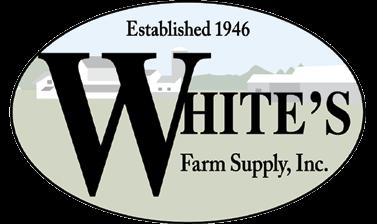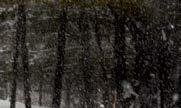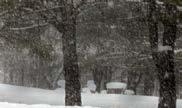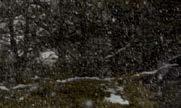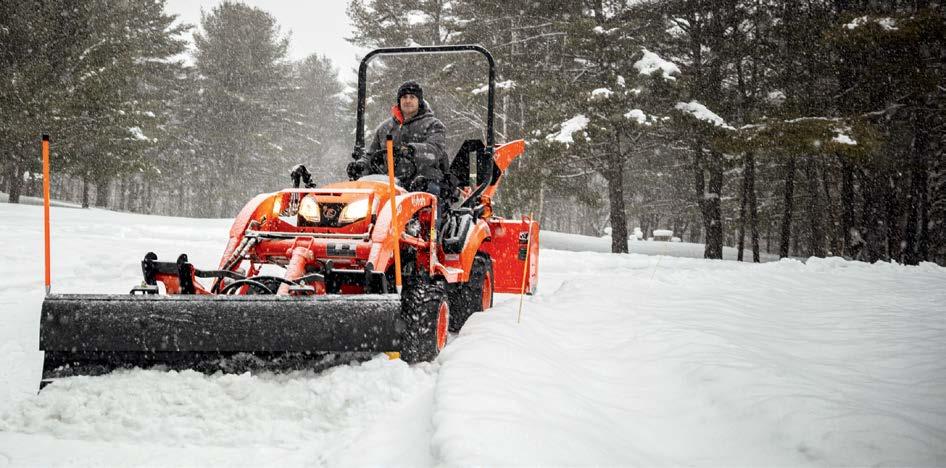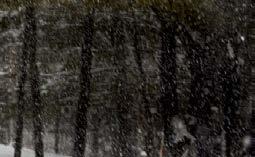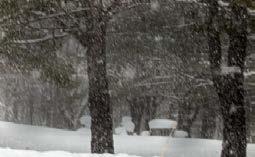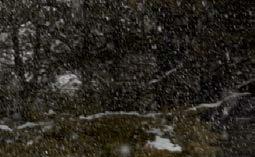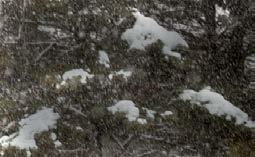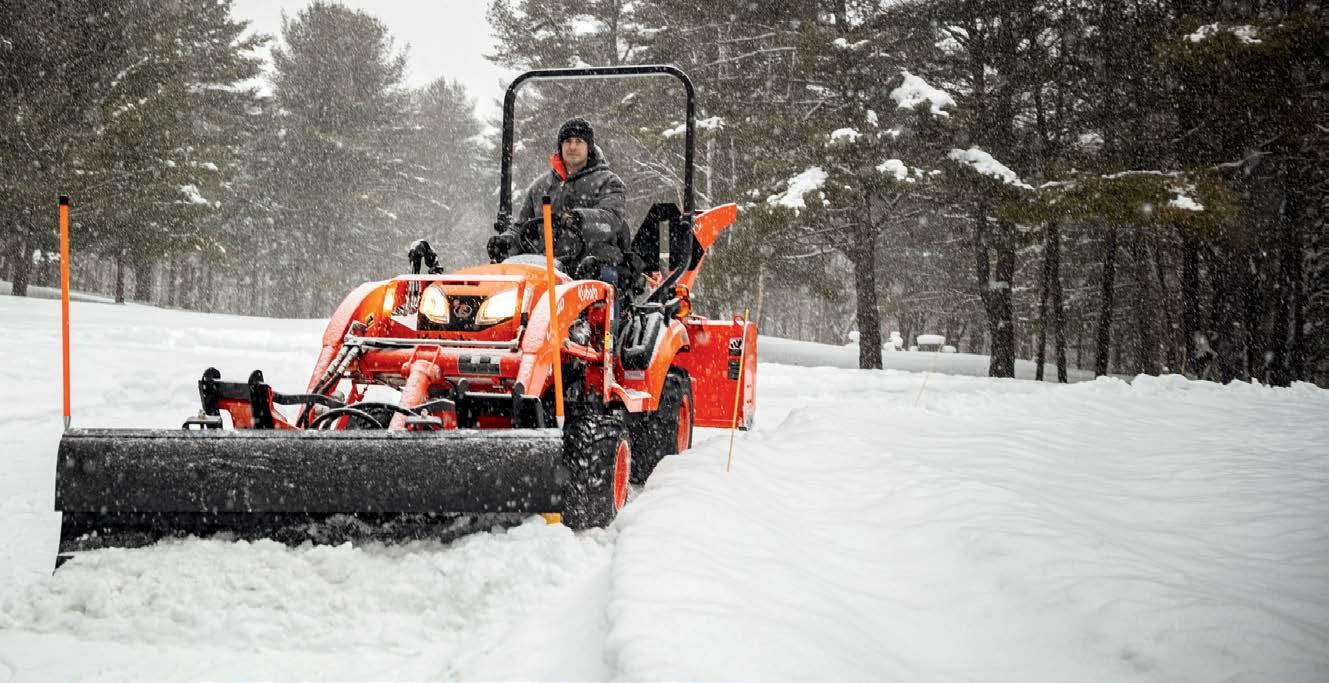






When holiday shopping this season, be sure you don’t overlook local antique and co-op shops. I recently found some treasures at the Mohawk Val ley Community Market in Herkimer. In addition to some pretty gift boxes, I bought a beautiful, hand made wooden step that flips up into a chair for my granddaughter. It’s not new. It had a previous life unknown to me, which makes it even more special. Who knows how long she will have this little piece of furniture? Will she use it in her first kitchen some day to get to an out-of-reach shelf? Will she have a little girl of her own who uses it to reach the sink to brush her teeth?
Recently during our “bonus” summer in No vember (when my fall chores were done and proj ects stowed away until spring), I decided to take ad vantage of the 60 and 70-degree days to work on a project that never made it onto my “to-do” list. My husband helped me drag an old dresser from our son’s former room out into the yard. I decided to re finish it. After stripping the thick, old, blotchy stain, I prepped and refinished the wood, just like I remem ber my mother doing with her antique furniture finds when I was growing up. I stood back and admired the beautiful woodgrain revealed. Suddenly, a mem ory of shopping with my mom at an antique shop for a dresser for my first apartment popped into my head. As the shop owner helped us load the dresser into my dad’s Suburban, I recall her saying: “Some day you can refinish this and it will be a nice piece of furniture.”
After the final coat of polyurethane dried, my husband helped me carry the dresser back up to our newly dubbed “guest room.” As I looked at the pretty “new” dresser, I thought of my mom (I lost her almost 30 years ago), our three boys who grew up using the dresser, and even contemplated its unknown former owner. I thought; you were right, Mom. It only took me 35 years to realize the gift you gave me. •
PUBLISHERS
Lance and Sharry Whitney
EDITOR

Sharry Whitney
DESIGN & LAYOUT Lance David Whitney

ASSISTANT EDITOR Shelley Malenowski
CONTRIBUTORS
Peggy Spencer Behrendt, Carol Higgins, Suzie Jones, Melinda Karastury, Rebecca McLain, Matt Perry, Cynthia Quackenbush, Denise Szarek, Gary VanRiper
CONTACT US (315) 853-7133 30 Kellogg Street Clinton, NY 13323 www.MohawkValleyLiving.com mohawkvalleyliving@hotmail.com
Mohawk Valley Living is a monthly magazine and television show that explore the area’s arts, culture, and heritage.
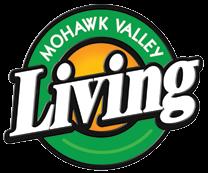
Copyright © 2022. All rights reserved. No part of this publication may be reproduced without the consent of Mohawk Valley Living, Inc.


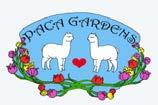



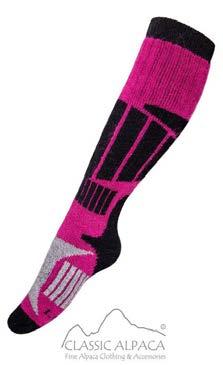
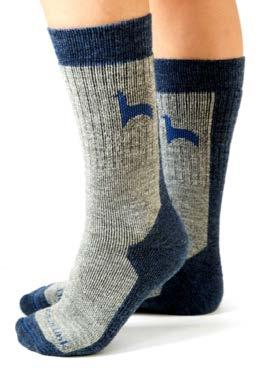
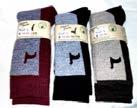



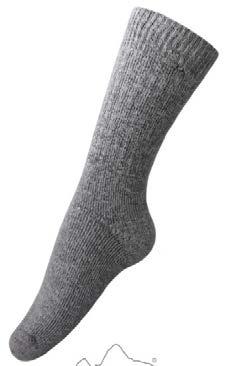






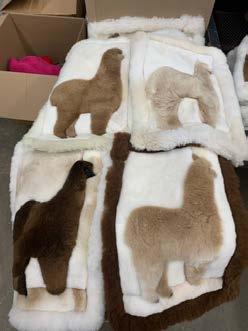


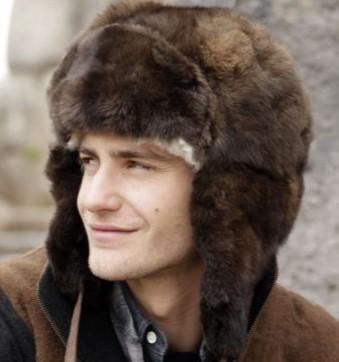

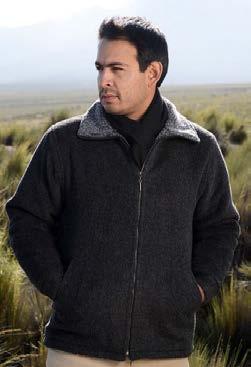

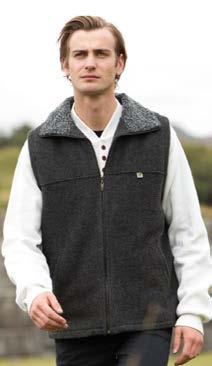



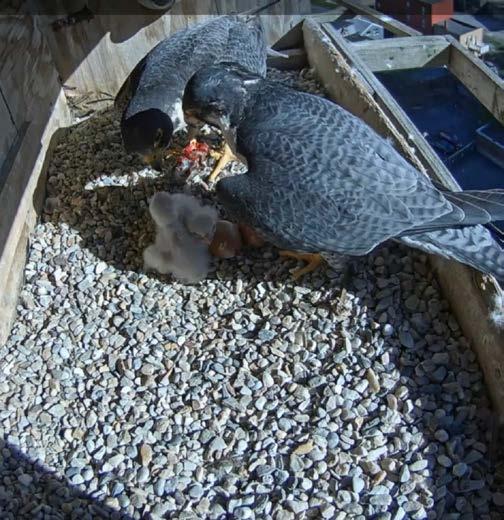

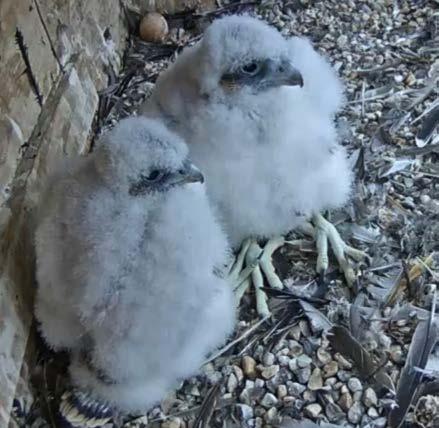




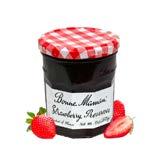






By May 8th, it was clear there would be no more than two falcon chicks in the nest this season. The reason the other two eggs didn’t hatch would remain a mystery. Hav ing only two mouths to feed would be easier for the parents since they wouldn’t have to procure as much food. It would also be easier on our fledgewatch volunteers since, come fledging time, there would be only two birds to keep track of and potentially rescue.
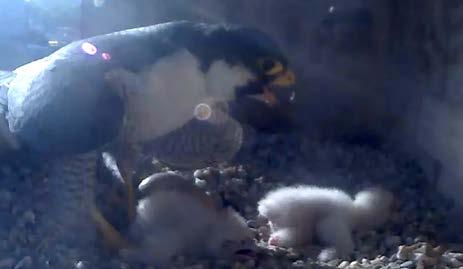
The morning of May 8th was unseason ably warm, and it got hotter as the day went on. In mid afternoon, Ares acted as a para sol and shaded the chicks from the sun. At 5 o’clock, Astrid showed up with a meal taken from one of Ares’ pantry ledges on the State Office Building. We expected that Ares would leave once Astrid came in and start
ed the feeding, but that wasn’t the case. In fact, he stayed and contin ued to provide shade through the entire meal. One falcon shading while the other fed nestlings was new behavior for our pair. It wasn’t a fluke; the following afternoon, they repeated the behavior – Ares shaded while Astrid fed the nest lings. This was yet another exam ple of the extraordinary level of co operation between these two birds.
On May 11th, by 4pm, the tem perature had again surpassed 80 degrees. Once again, Ares shaded the chicks while Astrid doled out the meal. When the feeding was done, Astrid went into shading mode alongside her mate. A few minutes later, they had split the clutch. Ares shaded the eggs, while Astrid shaded the chicks. At one point she attempted to take over the entire shading enterprise, but Ares was immovable. She gave scolding vocalizations, but he held firm. Determined to have her way, she went under her mate, scooped up the clutch with her wing, and pulled them beneath her..
By May 25th, the nestlings’ appearances were changing. They were no longer uni formly white. They had developed dark eye masks, and a fringe of feather shafts had be gun to protrude from the ends of their tails

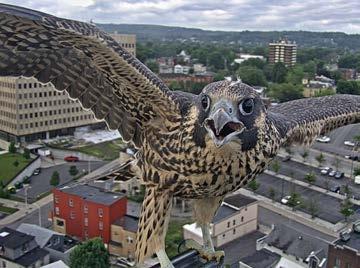







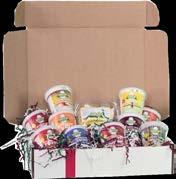
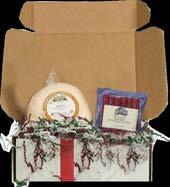




and edges of their wings. These were the be ginnings of flight feathers and a reminder to us that fledging time wasn’t far off. By this time, it was clear that we had one male and one female in the nest. Females are distin guished from males by their larger overall size, proportionately bigger feet, and thicker legs.
By May 27th, they had started exercising their wings and became more rambunctious. They bit each other’s tails and grabbed at everything with their feet. Increasingly, the nestlings became interested in what was hap pening outside of the nestbox. Their improv ing vision meant they could now track flying objects in the canyon. Both nestlings’ heads moved in sync as they watched their parents’ comings and goings, and they often reacted
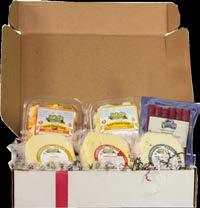
with squealing begging calls. On June 3rd, the young falcons received the names Kara and Percy, submitted to us via social media.
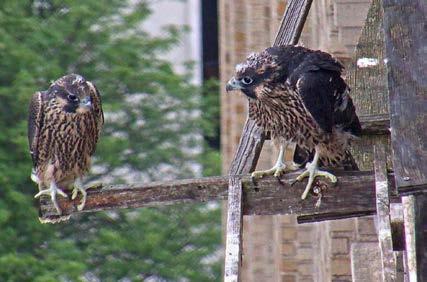
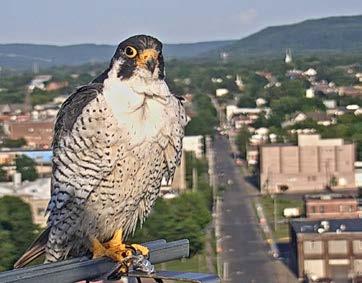
By June 4th, the nestlings had reached the stage of self-feeding. When a parent brought food into the nest, the nestlings quickly snatched it and absconded to the back of the box. From the start, Kara did this far more of ten than Percy. This is typical of female nest lings that tend to be more assertive. Indeed, she could intercept the food, but her ability to tear off bite-sized pieces had yet to develop.
Each season we watch for certain mile stones in the chicks’ development. Behavior al milestones include: their first time up on the lip of the nest box; their first visit to the box’s side platforms (verandas); and the first
time they go onto the cross perch and long perch. One of the last milestones we watch for is when the nestlings start venturing onto the window ledges beyond the verandas. We found it interesting that Kara nearly kept par ity with Percy. She did virtually everything he did, and sometimes only hours later. This was surprising since female Peregrines, with their larger body size, generally take more time to mature. Temperamentally, female nestlings, while dominant inside the nest, tend to be more timid in their adventurism outside the nest. On the afternoon of June 8th, first Percy and then Kara got up onto the lip of the nestbox. This is always a nerve-rack ing moment for us, when the nestlings first venture from the safety of the box. We are keenly aware that fifteen stories be low is a busy street. Of course, once a
then, Astrid landed on a window ledge east of the veranda. She does this to encourage their adventurism and to lure them over. Challeng es like these are what prepare young birds for fledging. At 6am, Kara successfully made it over to the east veranda and joined her brother. A little while later, Percy accepted his mother’s challenge and hopped from the corner of the veranda to a window ledge.
On the morning of June 14th, the two nestlings were active and intrepid. Both had been going onto the verandas and to the win dow ledges beyond. While he worked his way west along the ledges, Percy tripped as he negotiated around the base of a pillar. It was nearly an inadvertent fledging, but he caught himself and managed to regain his





grip on the ledge. At a few minutes after 10am, Percy was ready. He peered into the canyon, bobbed his head a few times and jumped into the sky. His wing flapping was strong as he headed towards the Grace Church steeple. At the last second, he decided against trying to land on the structure’s sheer walls. Instead, he banked right over Genesee Street and headed north towards the Doubletree Inn. He managed to maintain altitude as he approached the building, ultimately landing on the narrow ledge that runs along the hotel’s east side. He wouldn’t try to fly again for the rest of the day.
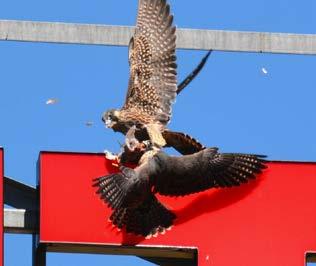

Early the next morning, he was flying again, this time with both parents as escorts. Percy attempted to land on the steeple but missed his mark and slid down the wall. Before sliding far, he found his wings and was able to flap his way back to the State Building where he put down safely on a window ledge. Soon he called out to be fed. As far as we knew, he hadn’t eaten since before fledging the previous day. After a nap and wing exercises, he played with both parents as he practiced flying.
Before sun rise on June 28th, we already knew it was go ing to be a big day. Kara had been doing se rious wing flap ping on the east veranda. That culminated in a flight up to the roof of the nest box. From there she glided back down to the long perch. This was significant, since the day a nestling goes up onto the roof of the box is often the day they fledge. Kara was no exception; at 5:44am, she fledged from the veranda. Just like her brother, her fledg ing was deliberate. She simply spread her wings and dove into flight. Once airborne, she flapped her way south and towards the Grace Church steeple. She tried to land high on the wall of the structure but, like so many fledglings be fore her, she failed to get a grip. She slid down, recovered, deployed her wings, and flew on towards the State Build ing. She attempted to land on a window ledge on the north face of the building but missed her target. She stumbled but then got a solid hold on another ledge below. She was about halfway up the building which was a safe enough height to be. As first flights go, it wasn’t too bad. Landings are difficult for all fledglings and Kara managed it without damaging herself.
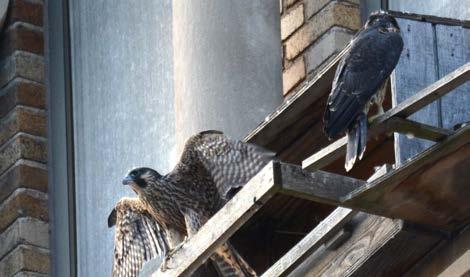
Kara’s next flight wasn’t until 5:50 the following morning; 24 hours after her inaugural flight. She simply flew out of view. But then, several minutes later, she reap peared on the roof of the Adirondack Bank. Percy joined her, landing on top of an antenna. Their reunion party was short-lived, and soon Kara was up and flying again. She







made her way north to the hotel and landed on top of the roof wall. Despite Kara’s lack of experience, her flying was competent. It was clear that both young Peregrines had successfully made it past the most daunting challenge in their lives thus far – fledging. There would be more challenges to come, but they were both well on their way to be coming full members of the world’s most elite class of raptors – the Peregrine Falcons
As the weeks went by, the young falcons’ skill sets continued to improve. By the begin ning of July, they regularly left the canyon and spent time in other sectors of their par ent’s territory. Whatever adventures they got up to, they typically returned to the canyon

and to ledges on the State Office Building to spend the night. The young falcons remained on their parent’s territory until close to the end of July. After that, they began their long journey southward – possibly to Central or South America. Independence for young raptors is full of challenges, and Percy and Kara were as prepared to meet them as any young falcons could be. If they return next spring, we are unlikely to recognize them. A complete feather molt will leave them look ing more like their parents. As for Astrid and Ares, they will remain on their territory through the winter months. Well before their young left town, they resumed courtship dis plays at the nest box, thus making clear their
intention to breed the following spring. In 2023, the Utica Peregrines will be celebrat ing their 10th breeding season together – an amazing achievement for members of a re cently recovered endangered species. •



Perry is Conservation Director and Resident Natu ralist


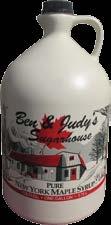

Spring Farm CARES in Clinton. He manages a 260 acre nature preserve which is open for tours by appointment. His nature videos and photos can be found on the Spring Farm CARES’ Nature Sanctuary Facebook page.
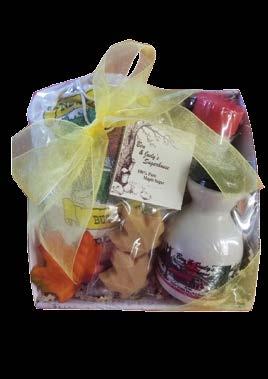


For years now, we have grown greens in our greenhouse in winter. Many of you enjoyed the salad mix we sold at the farmers’ markets and at The Tailor and the Cook. We experimented with different varieties, exploring the never-ending variation in flavor and appearance while listening to the requests of local chefs. We did many trials on soil, seed, and water pH to learn what each variety preferred.
Winter is one of the best times to garden! That’s right! Indoors on your kitchen counter! A common limitation many face when trying to grow their own food is the commitment it requires to take on a garden. Just as spring and summer are the busiest times in the garden, they are also busy times in folk’s lives. We are often called away from home during the summer months, leaving a well-intentioned garden a forgotten responsibility or a burden for a neighbor. Growing your own greens allows you to stop and start whenever you want, leaving you with less of a commitment.

Over the past twenty years, interest in local, fresh, and organic food has been on the rise. In the Mohawk Valley, there has been a revival of farmers’ markets, the inception of the CSA model (Community Supported Agricul ture), Food-Co-ops, and an overall movement toward clean, whole foods.

Growing your own greens gives you access to fresh, living greens all year long with minimal investment of money, time, or knowledge. The little amount of space required makes it the perfect fit for both urban and suburban families, who might not have room for a garden.
Aside from great taste, greens are also extremely nutritious. The ability to harvest and eat them within minutes gives you access to their most nutri tious state. Loaded with a strong dose of digestible vitamins, minerals, and phytonutrients, your taste buds will enjoy the intense flavor and your body will reap the benefits of concentrated nutrients.
Sprouts, microgreens, and baby greens are all stages in a plant’s devel opment. A sprout is the first stage of a seed’s development. Grown in differ ent types of containers, these seeds are kept moist and at room temperature until they germinate. Instead of allowing them to grow into an established plant, sprouts are consumed right after germination. They yield a crunchy texture.
Microgreens are grown in a medium (soil or potting mix) the second stage of a seed’s development involves the establishment of its roots and the opening of its first leaves, called cotyledons. Greens harvested at this stage are called microgreens.

If microgreens are allowed to continue to grow, they put on their next

set of leaves, called “true leaves.” True leaves are the leaves of a plant that distinguish it from another plant. It will eventually reach the baby green stage. Baby greens are tender leaves. They are more flavorful and tender than leaves from a fully-grown head of lettuce. This is the stage we like to grow at.
Due to the short time greens spend in their containers, any shallow re ceptacle will do. We think a standard 20 x 10-inch black plastic tray works best. These trays are easily available at garden supply stores or online. A shallow flower pot also works, but keep in mind clay pots can hinder ger mination by drying out too quickly and wicking water from the soil. Proper drainage is important. But if you have a restaurant supply store, you can get some of those clear plastic salad containers, or save them from your take-out meals. These make a great little greenhouse with an attached lid and are the perfect size to grow a lot of varieties of greens in a small area.
Soil is the heart of any farm or garden. Choosing the right soil to grow your greens is vital. We suggest using organic, good-quality potting soil to grow your greens. Make sure the bags are labeled with their ingredients so you know what you are getting.
After filling your trays with soil, you will need something to gently press down on the soil to create a flat seed bed. A piece of cardboard works well, and it’s free!
Quality seeds are another integral part of growing greens. Factors that will affect the viability of your seeds are storage, handling, age, and seed source.
When it comes to storing and handling your seeds, you will want to keep them cool and dry. Avoid fluctuation in temperature and moisture. Proper care of your seeds will maintain their viability for a longer time. Your seeds will last 2-5 years depending on the vegetable, with proper care. Remember, seed packets contain lots of valuable information, such as germination rate, age, and seed variety.

We only choose seeds for our farm, from small organic seed companies, such as Hudson Valley Seed Company, High Mowing, Bakers Creek, and Johnny’s Select Seeds.

Paper towels are a quick and effective alternative to covering your seeds with soil. Usually, you would cover a sown tray with a dusting of soil, enough to cover the seeds. With the number of seed trays we grow in a week, paper towels become the best alternative. Just remember to purchase

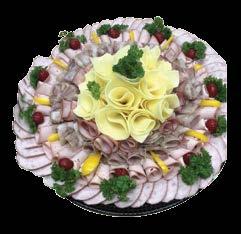
unbleached, natural paper towels. The purpose of this layer of soil or paper towels will be to provide a covering layer to keep your seeds warm and moist as they germinate.
Since you are growing the greens so densely, air circulation is very important. The key to good watering is to be gentle yet thorough. Once your trays are watered, you will need to cover them with lids if you are not growing in a greenhouse. Lids will speed up germination, hold in heat and retain moisture. If you are using plastic lids, you will want to keep an eye on your trays in direct sunlight. The lid can create tempera tures inside much greater than the air outside. If you notice that things are a bit steamy, simply remove the lid slightly to the side to create more ventilation.

As your seeds are germinating, it’s important to maintain proper moisture. With the paper towel method, watch the towel and observe the dampness and water daily. One of the benefits of the paper towel is it provides a window into the germination process. Instead of your seeds hidden from view under a layer of soil, you can simply lift the corner of the paper towel to observe the stages of germination.
Scissors are your best friend when harvesting greens. Buy a separate pair solely for harvesting your greens. Making a clean cut through the stem is one of the most important to the longevity of your greens. The less cell damage done at harvest, the longer they will hold.
When deciding how many trays to grow, your first consideration will be how many people you are feeding. Because the growing season is only a few weeks, it’s easy to start small and adjust accordingly. Each tray can be sown with a few different varieties so you can enjoy an as sortment of flavors and colors of fresh greens.
Our favorite salad mixes include: green & red oak leaf, red romaine, green & red leaf lettuces, spinach, red Russian kale, red-veined sorrel, and red frills mustard. But experiment and make your own mix.

Greens taste best with a light vinaigrette! •











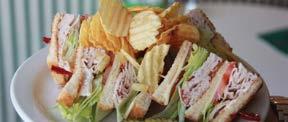









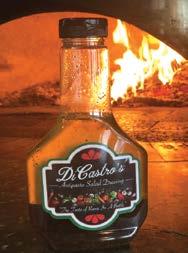










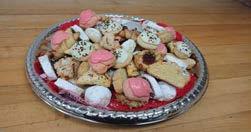
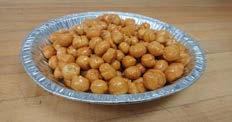
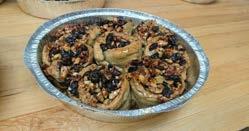






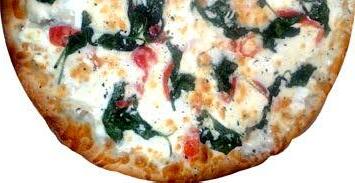


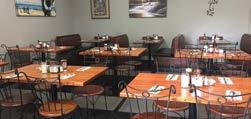




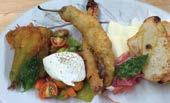














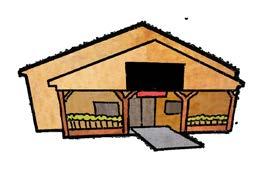


































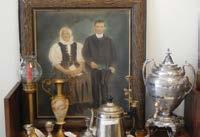





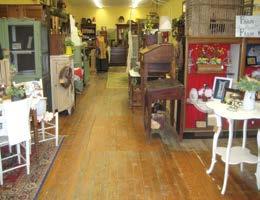

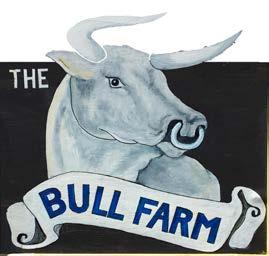









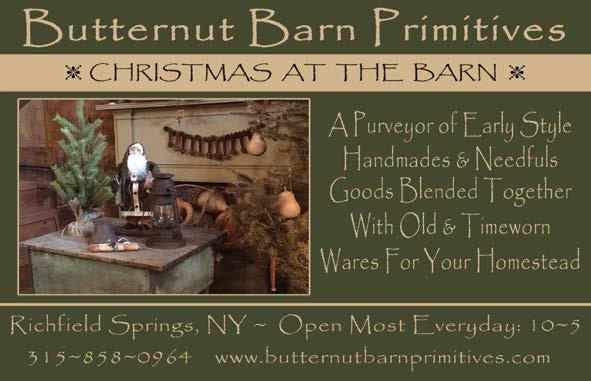
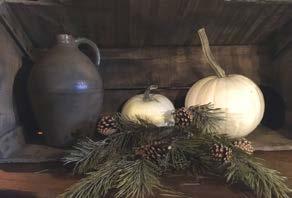
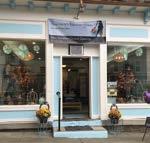





















Some consider winter in the Mohawk Valley to be a bird desert. A time when birds are largely absent from our landscape. This is not the case. There are between 60 and 80 species of birds that spend at least part of the winter here. Less than half are year-round residents, while the remainder travel here to avoid food deprivation in the north. The num ber of species that stay with us varies depend ing on the severity of the winter, the amount of snow cover, and the amount of available food. In December, many so-called “half-har dy” songbird species may attempt to remain in the region, but the inevitable onset of harsh er weather is usually enough to persuade them to head further south. The Hermit Thrush will sometimes attempt to spend the winter here but only rarely persists after December. In the breeding season, Hermit Thrushes inhab it dense forest in the north country as well as some of the Valley’s wooded ravines. In win ter, they may try to eke out a living in ber ry-laden forest edges and thickets. They share these places with overwintering American Robins and Eastern Bluebirds. These fellow thrush species have little trouble switching from a summer diet of insects and worms to a winter diet of fruit and berries. While Rob ins and Bluebirds are confident in their ability to continue to find food past December, the Hermit Thrush usually is not, and they seldom remain after the thickets are picked clean.


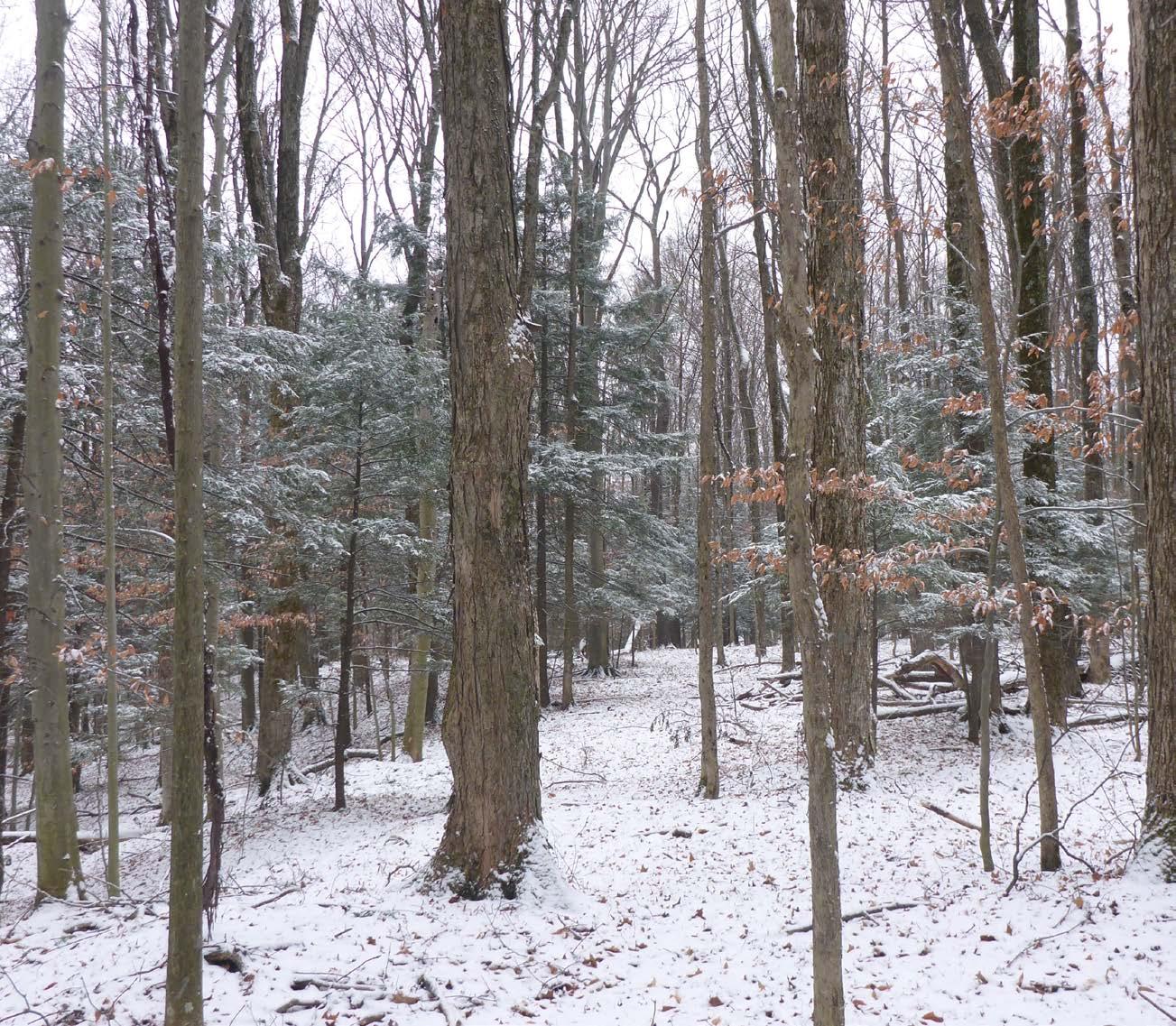
The Hermit may not be so winter-hardy, but they are hardier than the Win ter Wren. The Winter Wren will sometimes remain in the Mohawk Valley if winter re mains mild. Not as flexible in its diet as the thrushes, the wren depends on finding dor mant insects and spiders which they collect on or near the ground. Their hunting ability is easily hampered by snow cover and frozen soil. Overwintering Golden-crowned Kinglets and Brown Creepers manage to remain strict insectivores through the winter. Their ability to glean their quarry from bark crevices high in the trees gives them an edge over the more ground-centric Winter Wren. This being the case, while kinglets and creepers regularly persist through the depths of winter, we rarely see the Winter Wren after the first weeks of December.
There can be up to a dozen species of wa terfowl found locally at the start of December. Typically, they will be whittled down to about four or five species by month’s end. Mallards and Canada Geese are the most dependable waterfowl species to encounter in winter. In deed, if there is some open water available, they will stay. Common Mergansers are also reliable winter residents. They can easily in habit rivers and large streams. Since running water remains open and ice-free, mergansers can continue to catch fish through the cold
spells that cause the region’s ponds and lakes to freeze over. A few Wood Ducks and Hood ed Mergansers may also be found on stretches of open water, but they are never common. In the last twenty-five years, Snow Geese have taken to migrating through our region in De cember. It is possible to see many thousands of them winging through the sky or crowding local bodies of water and cut cornfields. Al though not classified as waterfowl, Great Blue Herons and Belted Kingfishers are just as tied to the presence of open water, and a handful of them typically remain in the region for at least part of the winter.

Many of our winter resident songbirds are also year-round residents. These non-migra tory species can make an adequate living from the sometimes-scant amount of food present during the heart of winter. This may seem a risky survival strategy, but by staying here they avoid the hazards associated with a long migration flight. Their more flexible diet sets them up to endure the vagaries of any single winter food resource. Those of us that have bird feeders know most of these year-round ers well. They include the Wild Turkey, Ruffed Grouse, Black-capped Chickadee, Tufted Titmouse, White-breasted Nuthatch, Northern Cardinal, Mourning Dove, Downy
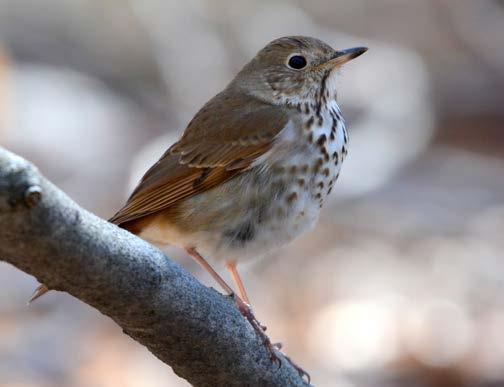
Some popular winter resident songbirds are migrants from the north. These birds come here specifically to avoid harsher winter conditions on their northern breeding grounds. These species include White-throated Sparrow and Tree Sparrow. Some of our winter resident songbirds belong to species that are also represented here during the breeding season. However, those individuals that spend the summer here migrate south and are replaced by an identical population arriving from the north. Songbirds that carry out this seamless changeover include the American Robin and the Dark-eyed Junco.



Irruptive songbird species are those that lead a nomad ic lifestyle based on where the food is. Irruptive species include many of the winter finches. If the spruce cone crop is lacking in the far north, some may travel thousands of miles to other forests where the crop is more substantial. Other irruptive species make similar decisions based on the presence of their preferred food. The Cedar Waxwing and Bohemian Waxwing are not finches, but their nomadic life styles lead some to characterize them as honorary finches. In their case, it’s the fruit and berry crop that compels them to travel. In the Mohawk Valley, we may go several winters without seeing some of these species, but when they do show up, it can be in great numbers. Finches and waxwings are not the only bird species prone to irruptive behavior. Populations of Blue Jays and Red-breasted Nuthatches are also known to move considerable distances based on the



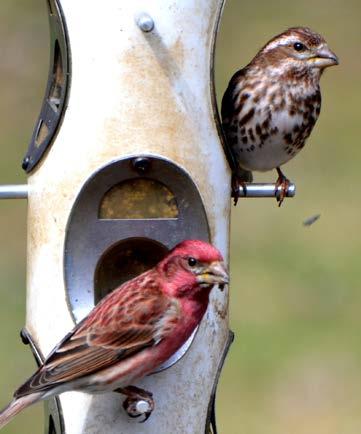
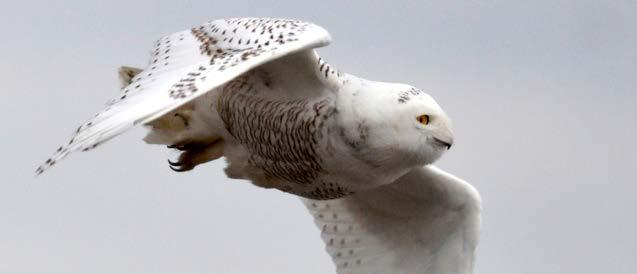
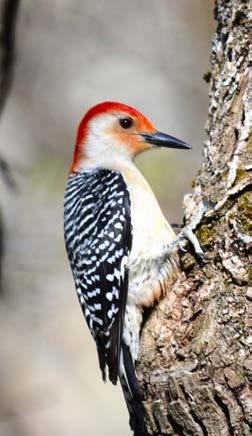






















There are up to twenty species of raptor that can be encountered in the winter in our region. However, in a typical winter, we expect to find about half that many. Our most reliable winter resident raptors include Red-tailed Hawk, Cooper’s Hawk, Great Horned Owl, Barred Owl, and Eastern Screech Owl. Less common ly encountered raptors include Rough-legged Hawk, Snowy Owl, and Short-eared Owl. The Rough-legged Hawk and Snowy Owl will show up in our region in years when the vole and lemming populations crash in the far north. Eagles are becoming an increasingly common sight in the Mohawk Valley in winter. The secret of the eagle’s ability to remain in a region with little open water is its ability to switch from eating fish to feeding on carrion. Golden Eagles typically migrate through the region in November, but some continue to pass through in December. Occasionally a few will remain for the winter. Like the Bald Eagle, Golden Ea gles can make a decent living off roadkill. Far from being a bird desert, December is a time when birds may just take a little more effort to find. It all comes down to knowing their habits and knowing where to look. If you go out searching for them, be sure to check the waterways and the cut corn fields. Also, be sure to pay a visit to berry-rich thickets and forest edges. You may find more than you expected. •


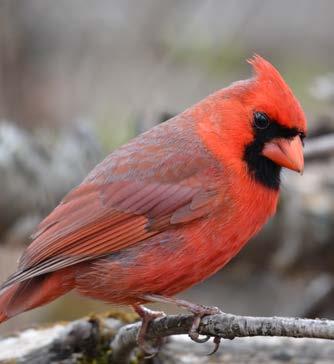
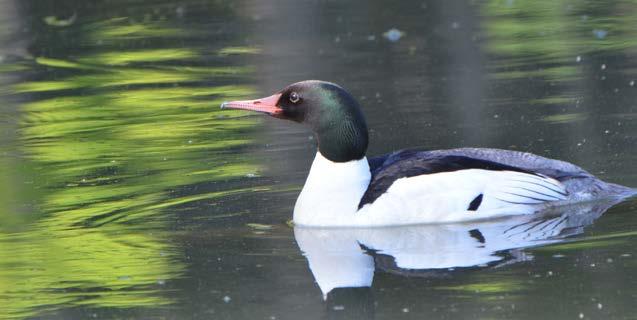
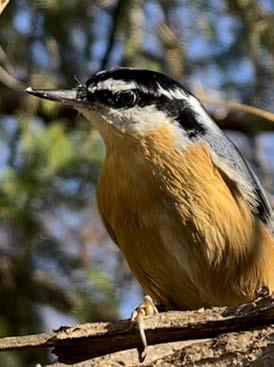


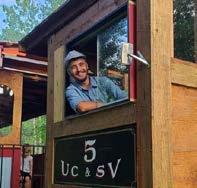

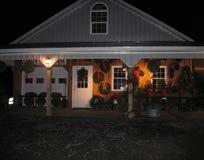
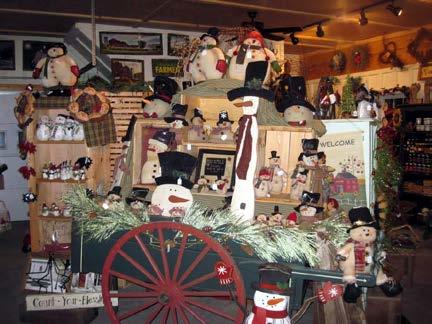





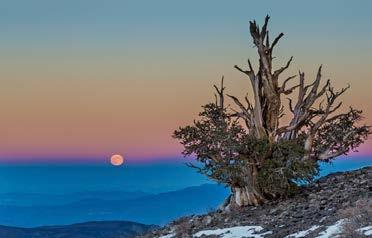


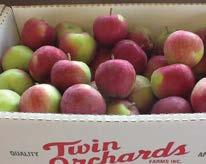
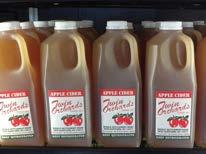
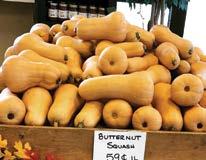




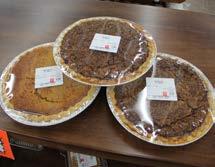
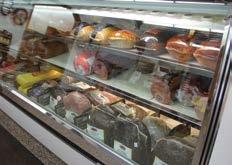

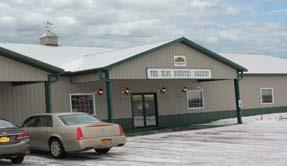
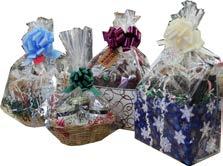
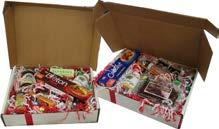

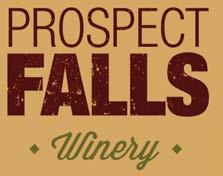
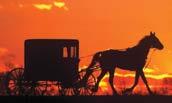
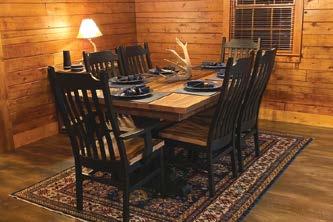
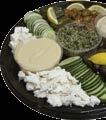
This month marks the return of our old friend, the one who ushers in the season and turn raindrops into snow and ice. Old Man Winter arrives on Decem ber 21, the official start of winter and the day with the least daylight. But snow and ice are not unique to Earth. There are a surprising number of places in our solar system where snow and ice are found. Let’s take a look at a few, starting with our nearest neighbor.
The stark surface of the Moon is covered with craters due to millions of years of impacts by asteroids and me teors. Although it seems to only have lava fields, ancient volcanoes, rocks, and fine powdery particles called rego lith, it is a different story down in some of the deep craters where sunlight nev er shines. Here we find water ice! This discovery was made in 2009 as a result of data captured by NASA’s LCROSS spacecraft and Lunar Reconnaissance Orbiter (LRO) sent to the Moon on an unusual mission.
The data collection began when the LCROSS Centar upper stage separated and intentionally crashed into Cabeus crater near the south pole. LCROSS was close behind, flying through the debris field four minutes later while transmit ting data and images it collected before also crashing into Cabeus. Meanwhile, LRO, orbiting overhead, captured more data about the entire event, providing
proof that water ice was detected. NASA’s Arte mis program intends to investigate the south po lar region as a potential source of water for future crews and rocket fuel.
The polar regions of Mars have ice caps that grow and shrink as seasons change, and in 2008 NASA sent the Phoenix lander to the north pole region to in vestigate the composition of the ice and soil. Using a scoop at the end of a robot ic arm to dig trenches about two inches deep it collected surface soil samples. The material was analyzed by onboard “chemistry lab” science instruments, and the tests confirmed water ice was present. Phoenix also detected snow falling from Martian clouds.

Oh, here’s a fun Phoenix mission and Mohawk Valley connection. Did you know the scoop that collected the sur face samples (inset photo) was built by Custom Tool & Model Corporation (CTM) in Frankfort, NY? CTM was awarded a NASA contract to build the scoop that played a crucial role in the mission.
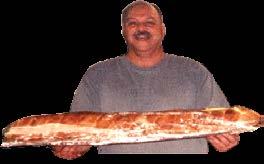
Beyond Mars is an impressive list of snowy and icy worlds. Jupiter alone has four notable moons:
Europa’s solid water ice surface is 10-15 miles thick and covers an under ground ocean believed to hold twice as
much water as Earth’s oceans.
Beneath Ganymede’s icy shell is a salty ocean that may contain more water than is on Earth’s surface.
Callisto has a rocky, icy surface with the most craters in the solar system and bright white spots thought to be water ice at the crater tops.
Io has volcanoes that erupt and spew sulfur dioxide hundreds of miles into space where it freezes and falls back to the surface as snow.
Saturn’s icy moon Enceladus is in teresting. Geysers shoot jets of water from the underground ocean through cracks in the surface and out into space where it freezes. Some ice falls back onto the surface, while the rest ends up in Saturn’s rings.
And last but not least, even dwarf planet Pluto has methane snow and ice on a chain of mountains.
As we can see, snow and ice are abundant in our little part of the universe and coming again soon, if not already, to our part of planet Earth. Get your skis and boots ready!

Wishing you clear skies! •
 Hanny’s Voorwerp. Image Credit: NASA, ESA, W. Keel, Galaxy Zoo Team
Hanny’s Voorwerp. Image Credit: NASA, ESA, W. Keel, Galaxy Zoo Team
Across
2. The aptly named horse of Tim’s grandfa ther. See Shawangunk.
4. “Where” Valley Girl likes to shop.
6. The name of the male offspring of Ares and Astrid.

8. What gift did young Beatrice receive for Christmas in 1933?
10. Like Hans Christian Andersen’s toy soldier.
11. Like Rudolph’s nose.
12. Santa’s right-hand man.
Down
1. Suzie offers up a recipe for this in a cup.
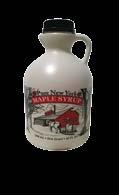

2. ____ Gardens, the best place for alpaca socks (and sweaters, hats, mittens, blankets...) See page 5.


3. Despite its name, this thrush is not a fan of frost. See “Birds of December.”
4. Like the town of Bethlehem.
5. Not The Mighty Ducks, this local hockey team’s namesake is the “spirit of the ADKS.”

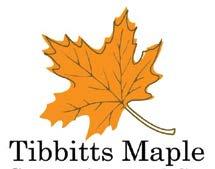

7. “Ox” of the Himalayas. 9. This part of NASA’s Phoenix lander was made at Custom Tool & Model (CTM) in Frankfort, NY







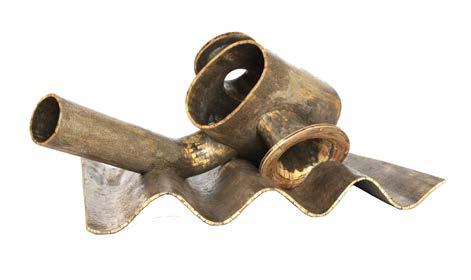
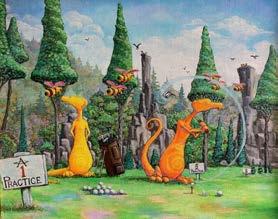
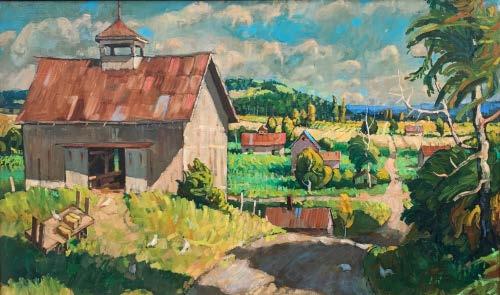



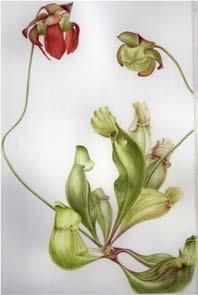
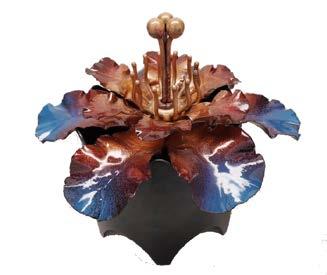
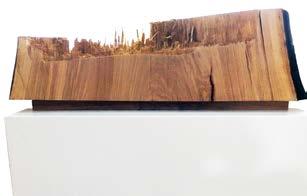




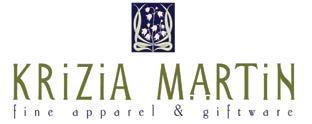











 by Rebecca McLain Executive Director, Oneida County History Center
by Rebecca McLain Executive Director, Oneida County History Center


As the holidays approach, many of us reflect back on years past. Traditions have changed over the decades. For many, it was and is a time to gather with family and friends and share food, fun, and memories. As we grow older, some of our most cherished memories come from childhood. The memory that follows comes from the childhood of Beatrice W. who grew up in Utica. This story was saved as part of a series of oral histories collected by the History Center in the early 2000s to capture the memories of our community. It is being shared to help this memory, and our own holiday memories, endure for generations to come. Happy holidays to all.
“I couldn’t have received a better gift on Christmas morning in 1933. The Great Depression was in full swing. Dad worked a couple of days a week at P.W. Schneider’s and occasionally someone would call to request his service for a necessary carpenter repair job. It was usually an emergency



situation. They would ask Dad if he could wait a week or two for his pay. He always did the work but didn’t know when he would get paid. I never realized how hard it must have been for Mom and Dad to “scrape” up the money for those rubber-tired roller skates. I loved to skate and had worn out a couple of pairs of skates with metal wheels. When Dad and I went shopping for a new coffee percolator, a Christmas gift for Mom, I spotted the rubber-tired “beauties.” Dad thought they were great too. (Today you would say they were “cool.”) He must have talked it over with Mom because on Christmas morning, the skates were under the tree. All winter I skated round and round in the cellar and couldn’t wait for spring so I could get out on the sidewalks. One very windy day, I asked Mom for an old sheet and my friend Jean and I skated up to the farther end of Brookline Drive. I held onto one side of the sheet and Jean to the other. The sheet acted as a sail and before we knew it we had sailed the whole length of Brookline Drive. What fun!!! No one worried about the traffic as a car seldom traveled the street...few cars in those days. I’ll bet Mom and Dad appreciated those rubber tires too, because they weren’t as noisy as the metal ones when I skated in the basement.” •
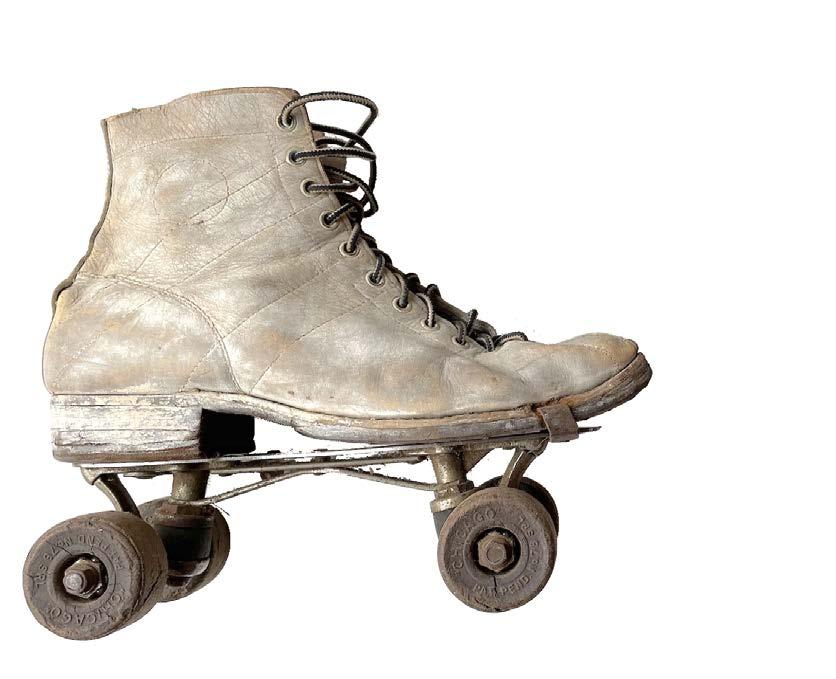
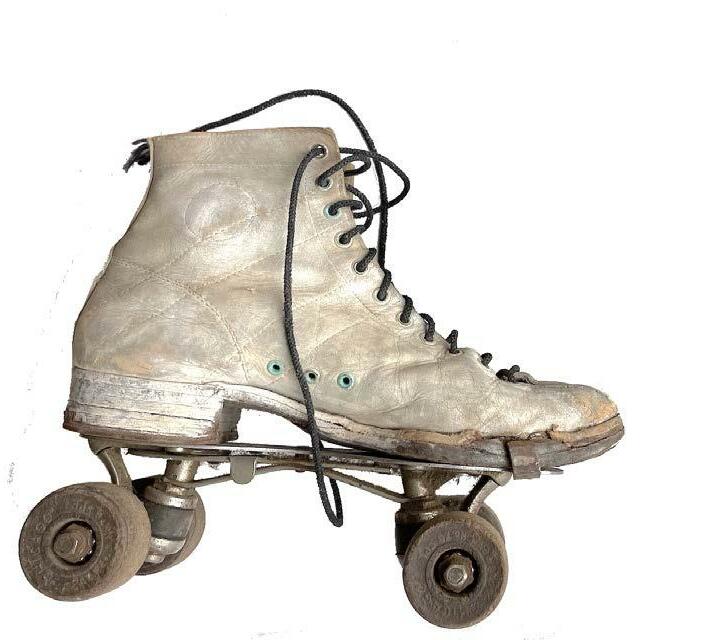





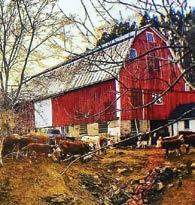



Most folks who know the Adiron dacks are familiar with Common Loons that by now have migrated from lakes for the ocean to prevent entrapment by the incoming ice. But how many folks are yet familiar with The Mighty Loons that are most active on the ice all winter long in Inlet of the west-central Adirondacks?

The idea for this youth hockey program was hatched by Fourth Lake seasonal resident Steve Schanely which resurrect ed the Inlet Youth Commission’s program that had been dor mant for a number of years.









The approved proposal resonated with a number of local citizens who came together to establish a Learn to Skate pro gram for area youngsters.
Current board president, Bret Thompson, who also serves as a coach, said the group did not expect more than 15 kids to sign up initially, and were surprised at the enthusiastic response. “Registration went up to 70 kids, and 49 showed up on the ice,” he said. By the end of the winter, a majority were playing hock ey with the balance learning to skate.
Those involved with hockey at any level know how ex pensive participation in the sport can be. And yet The Mighty Loons were able to accommodate all participants free of charge. How? Thompson explained, describing the generosity of so

many people and several organizations near and far. “We kept getting donations from the community,” he said. And they still do! Enough so that program organizers were able to completely outfit 50 kids with full sets of equipment and also make improvements to the Fern Park pavilion where the youngsters practice and play. Thompson listed new floor mats, LED lighting outside and over the ice, a new rink liner as among those modifications. Several men also fashioned a homemade Zamboni for resurfacing the ice.
It was Thompson’s roots in youth hockey that brought coaching experience to the program and donations of much of the needed equipment. He and his family now reside in Old Forge, NY, but he reached out to the community he called “Hockeyville:” Clinton, NY, where he had grown up and played sport. He described the response from both Clinton and Whitestown as “enormous,” supplying what he called ‘”truckloads” of player and goalie equipment.



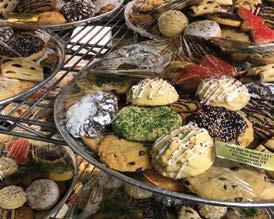
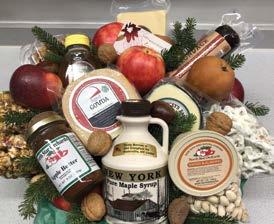

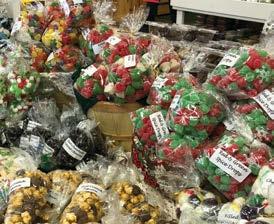
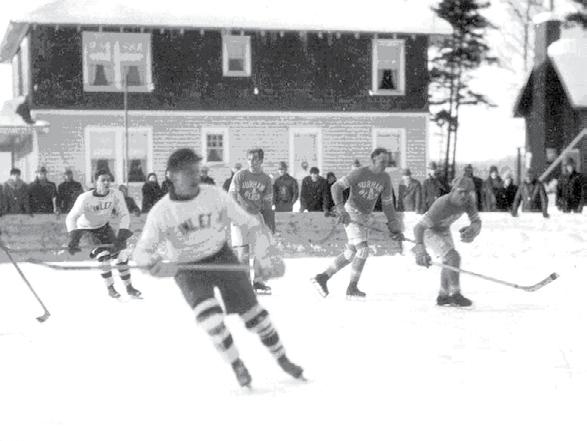


The Mighty Loons are now entering their second win ter, but because they started so late last season are only with in their first full year. Still, the program is already registered with USA Hockey, and, while the players are not yet ready for league play, they appeared together for an inter squad scrimmage on the ice last season for the Utica Comets and have caught the attention of the NHL as well. The Mighty Loons are scheduled to appear in the first intermission at the Buffalo Sabres vs. the New York Rangers game on Satur day, March 11, 2023 in Buffalo, NY!
I asked Thompson if he had any future Olympians in the program. Thompson was quick to reply that the empha sis on the program, with its 11 board members and half a

dozen coaches, is for the girls and boys to be safe, learn, and have fun.



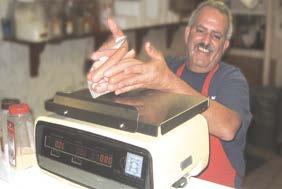

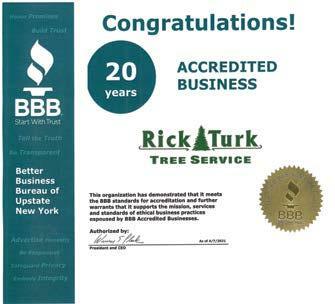

It proved to be a fun question to ask, as it brought to his mind The Mighty Loons first real practice ever, which happened on February 22, 2022, the 42nd anniversary of the now legend ary USA hockey victory that took place during the 1980 Winter Olympic Games in Lake Placid. Now known as the “Miracle on Ice,” a USA team comprised of amateurs and college students managed a 4-3 win over a powerful Soviet Union team that was considered at the time to be the best men’s ice hockey team in the world. Team USA then went on to defeat Finland for the Olympic Gold Medal.

Thompson reflected on the great experi ences and lifelong friends he has made during his own involvement in hockey and looks forward to the day when his 2-year-old son will also be playing. He is thankful there is this growing program and facility so close to home where his son and other boys and girls will have opportunity for the same kind of ex periences and relationships in this Adirondack town where mountains and memories meet. •



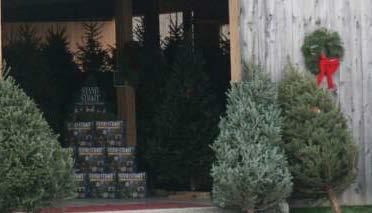


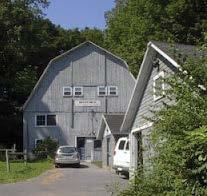

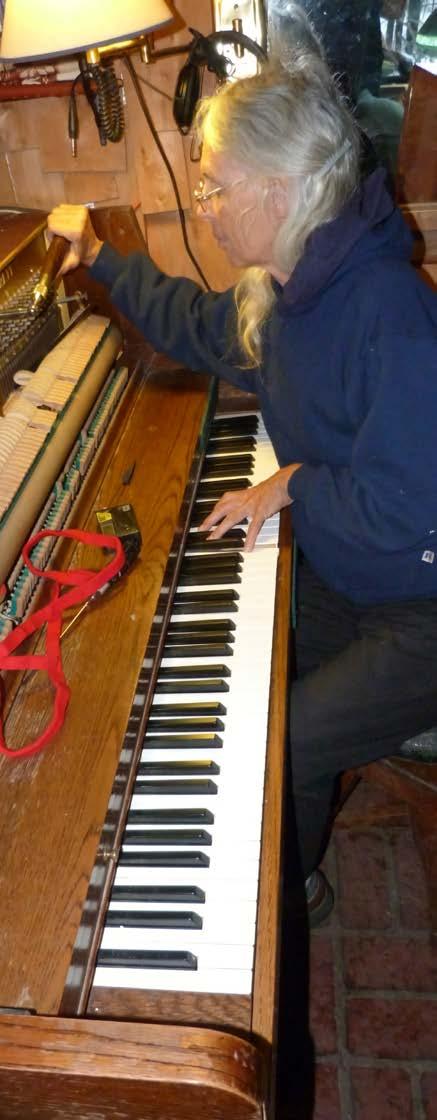


Tim’s grandfather, Rev. William Hume of southeast Ohio, served more than one church on Sundays during part of his ministry. He traveled between them on his horse, aptly named “Preacher”. It sounds romantic; fresh air, golden sun shine on the top of an amply brimmed straw hat, ambling along crystal rivers and cheery streams, friendly farm folk greet ing you from homesteads along the way, the cheery clippity-clop of horse hooves, and swish of a tail. I wonder if Preacher was ever urged to gallop because time was tight between services. Sometimes it rained and well-traveled roads became muddy and boggy from horse hooves and steel-rimmed carriages. Were he and Preacher tormented by aggressive horse flies and noxious swarms of mosquitoes in summer? Rev. Hume must have had a cold nose and hands at countless times from bitter winds and frosty temperatures in winter.
Like Rev. Hume, his grandson Rev.








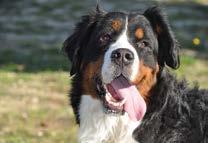
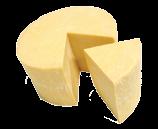
Tim often served more than one church on some Sundays. Trips between services could be intense when the time was tight and the weather unkind, even on the modern luxuries of paved roads and motorized vehi cles.


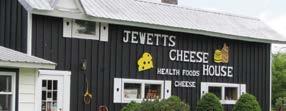
Particularly mem orable are Christmas Eve services. The first one at our Salisbury Center church had an abundance of ador able children partici pating in a Nativity scene, replete with bathrobes, halos, and a baby doll of Jesus. The sanctuary was filled with the thumpity-thump of busy feet on the hollow, hardwood floor and emphatic stage whispers to wayward actors which muffled the reading of the biblical text; but it didn’t matter because everyone knew the story. Watching teachers and par ents attempt to herd the children into their correct stage positions was a fun part of the entertainment. One of the lit


cacophony when she discovered the thrill of jumping from the stage to the floor, climbing back up the steps, and jumping off again over and over. No admonitions would deter this angel from the thrill of her first, thrilling, short flight.
Tim and I regretfully had to leave be fore we could greet all the parishioners and scurried out to face the terrors of a


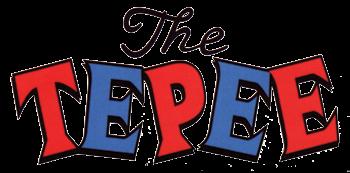
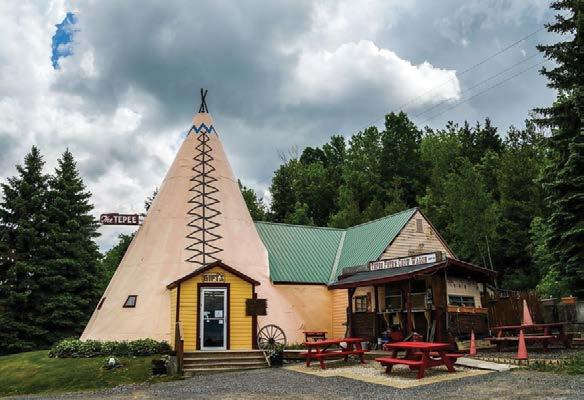

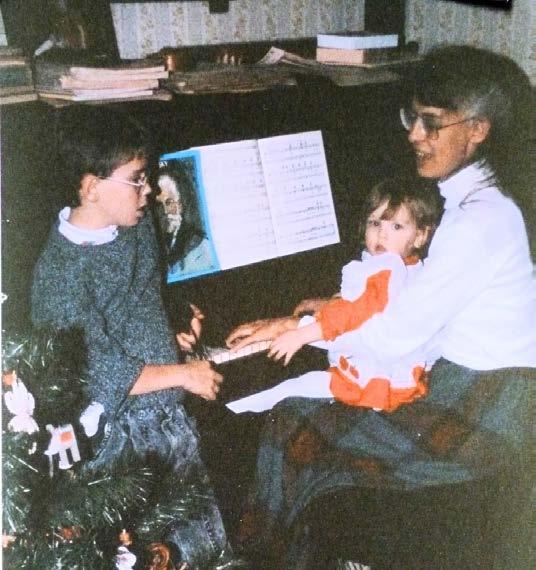


hurried trip from the Ad irondack foothills down to the Mohawk Valley in semi-blizzard conditions.

At that time, we were us ing a somewhat dilapidated, hand-painted 1966 VW Bee tle, because we needed our car fund to purchase land for the Preserve. We’d named it Viktor after Viktor Frankel, a neurologist and psychiatrist who survived Auschwitz and was able to share profound insights on his experiences de scribed in “Man’s Search for Meaning”. He created a form of therapy based on the premise that the search for life’s meaning is a central human motivational force. His book was helpful to us in our personal quests for self-under standing, and the fact that he could survive a death camp made us optimistic that we could survive travel in a flimsy old Beetle.
Tim was a careful driver but going as fast as one safely can down a steep wintery road, worrying about the possibility of sliding into a ditch or a stop sign, or get ting blown off the road by a blast of bliz

zardy wind is supremely scary. We peered intently through the frosty windshield minimally cleared by the weak defroster and tiny windshield wipers. There was no heat to speak of either, so I sat on my cold seat, crunched up under my old wool mili tary coat, appropriately forming a near-fe tal position.
But we made it safely and in time, and gratefully entered the warm, well-lit Utica edifice after cracking our cold and strained facial muscles into a cheery smile. We left the emotional trials and stress of travel be hind, visited the bathroom to freshen up, and focused on leading a beautiful service of uplifting music, thoughts, and poetry for dear parishioners and their families.
Most of us suffer from stress, perfor mance anxiety, and nerves, but must learn to function with it, or despite it, while on stage, hoping that the spirit of our presen tation will transport not only ourselves but our audience to a higher consciousness where such worries can disappear “Some where Over the Rainbow.” I’ve always struggled with it, and still do, but can usu ally “pretend” confidence, like the words in an old song from “The King and I”. “Whenever I feel afraid, I hold my head erect and whistle a happy tune, so no one


will suspect I’m afraid…”
I remember seeing a video of an aged, famous conductor in frail condition, hunched over, shuffling backstage, ap pearing to barely make it with assistance to the curtain. When he was announced, his back suddenly straightened, and he walked smartly to his conductor’s podium - the antithesis of the person he had been behind the curtain.
I’ve always particularly admired Tim’s ability to speak in front of an audience. He spoke for me, too, sharing things we both believed, trying to educate, entertain and inspire while I did it through music. I often wonder if people comprehend what is behind a musical performance. The ad age that it takes 1% inspiration, and 99% perspiration is quite true. Years of study and many hours of practice go into learn ing an instrument and learning to func tion in front of an audience in a state of adrenalin. Occasionally, a natural talent or genius appears, but most musicians worth listening to are dedicated, disciplined, te nacious lovers of music who’ve invested a big chunk of their lives and money to be able to share a song with you.
The cost of a quality instrument, a protective case, and maintenance are not cheap, either. Because of cost, I had to






learn to do minor repairs and tuning on my piano, and other instruments. I was too intim idated at first to think that I could repair a piano until a female friend said, “It just comes apart one step at a time.” When my keys begin to stick, it could be because of swelling due to humidity, but more of ten, our ubiq uitous mice have been having play dates inside my instrument, leaving calling cards that fall between moving parts.
Peg accompanied The Crecendos and other groups in High School
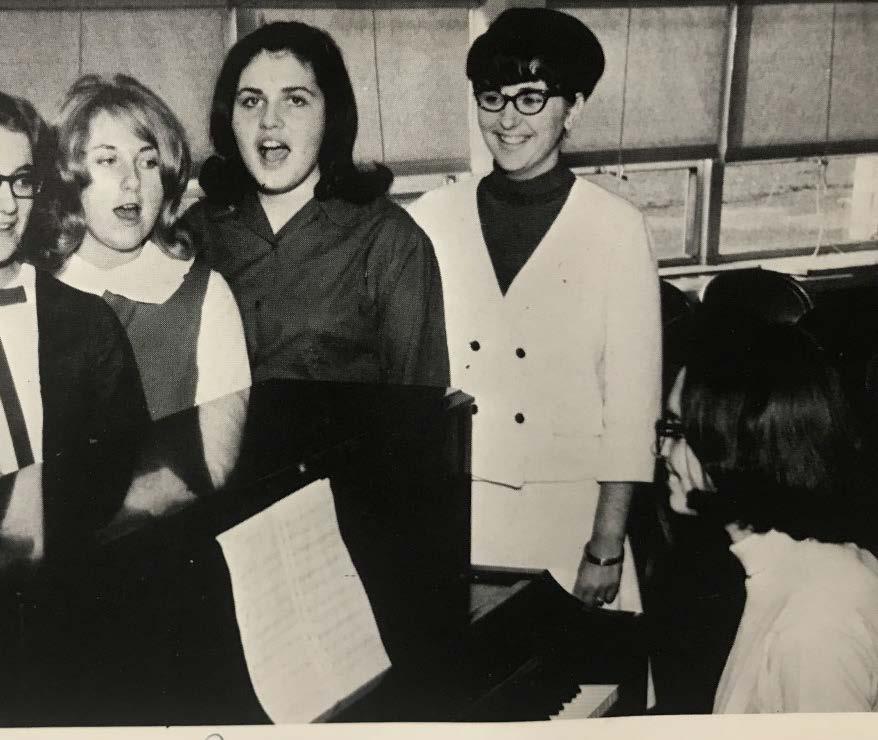
kept a positive, cheery atmo sphere, but before a program and during rehearsals I’d get so tense and frustrated I would yell at Tim sometimes, quit, disband the duo, or stomp out, hating him, every body, and everything…then feel sorry af WWW.HBEGROUP.COM HERKIMER • 315-866-3140

ward.
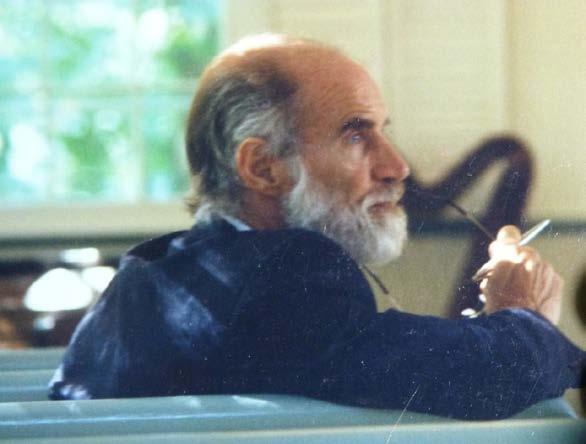
After the program, I’d be relieved and pleased that we did it and be particu larly happy to remember that I still love my friend/husband/music partner!
I admire music teachers and parents who patiently listen to young learners day in and day out for years. I can still hear my mother’s voice calling out from the kitch en; “You’re playing something wrong there!” during practice. I am grateful that

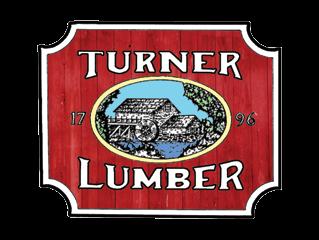
they thought it worthwhile to pay for lessons.

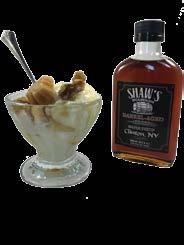
Before and during a performance, I tried many different techniques to calm my nerves and negative mind chatter. “It’s not that important.” “You’ve practiced, you’ll be fine.” “Just have fun.”
“Just do your best.” May be it’s helped. Sometimes I did push-ups just before going on stage to relieve tension.
When a piece goes beautifully it’s usually because I really love that song and am focused on ex pressing feelings with it. I get so wrapped up in it that the outside world and audience are only a shadowy distraction. One time, I was particularly inspired by the lovely, high-quality piano I was playing and en tered this Mystical Music Zone, loving the beautiful sounds and nuances I could cre ate on it. Afterward, I was shocked to get our first standing ovation.
Reading an old diary recently, I was surprised to discover that I had the same
of emotions in High School. In my Junior year, I was an accompanist for three vocal groups at school. I respected our director, Mr. Davis, but resented taking directions from my peers in the smaller ensemble. Sometimes I carelessly played forte when they wanted piano or went allegro when they wanted andante. Finally, very inconsiderately just before the Christmas concert, I quit.
I wrote in 1964 (Age16).
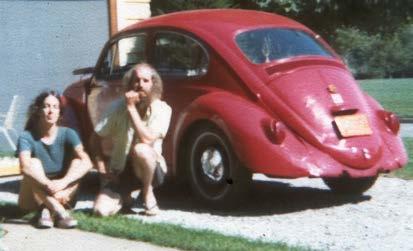
Dec. 3. I went after school to rehearse with The Crescendos. How I hate it! BP said, “You better take these pieces home and practice them. They need work.” She gets my goat!
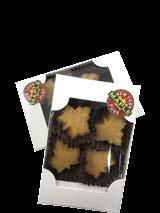
Dec. 4. Mr. Davis said they’d told him they were unhappy with my work. I wouldn’t go loud or soft when they want

Old Viktor the VW helped us pay for Preserve land
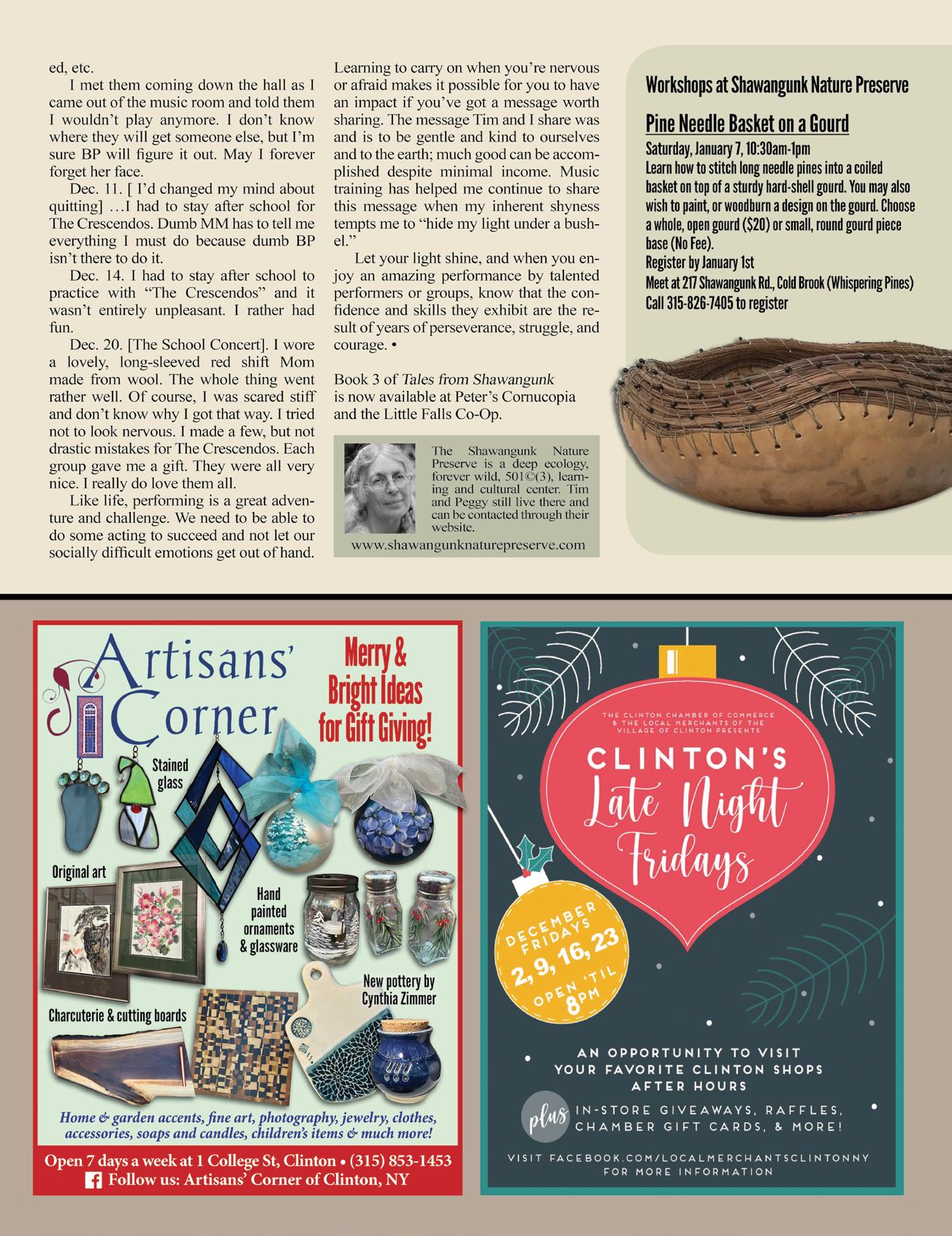
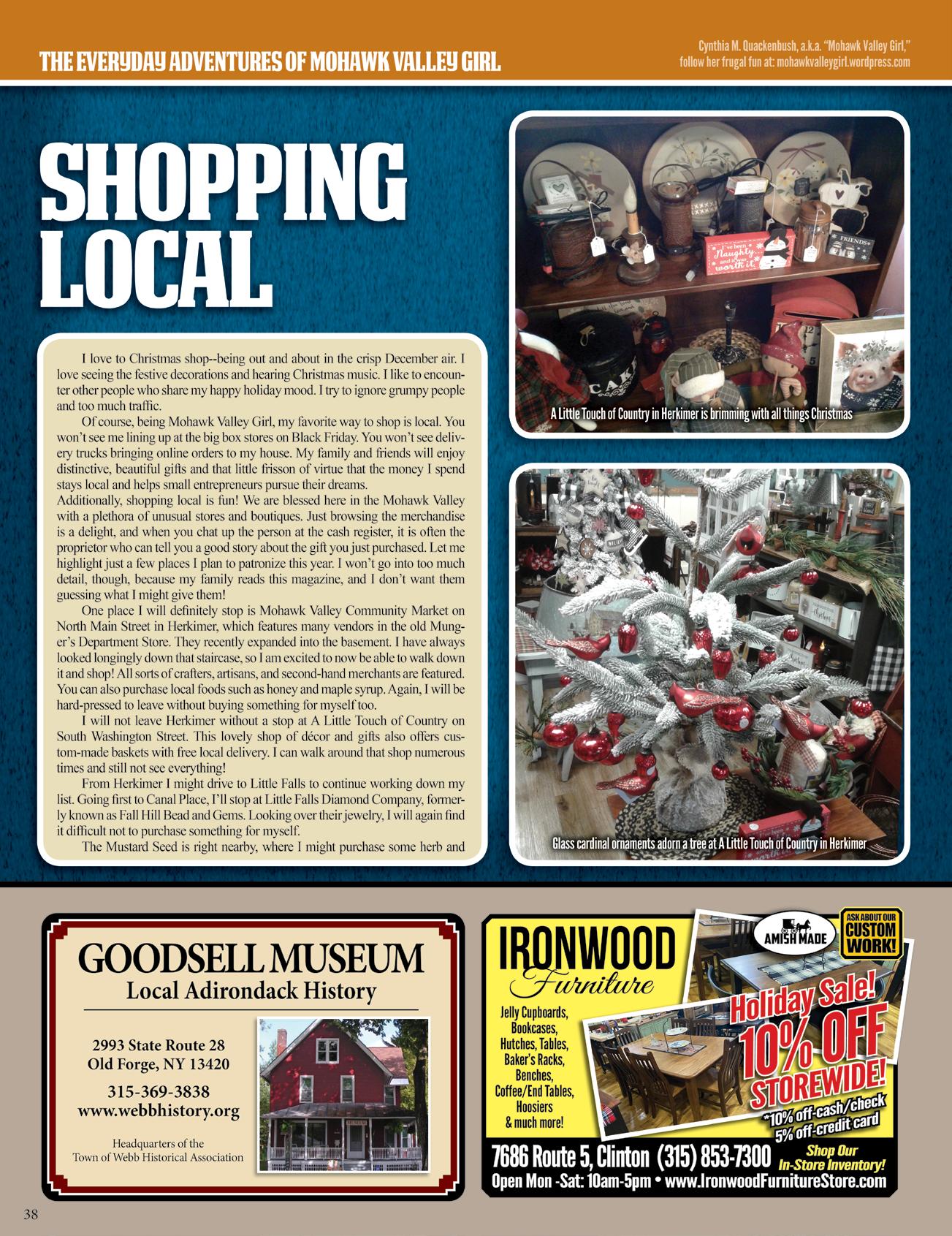
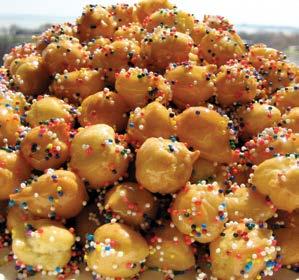
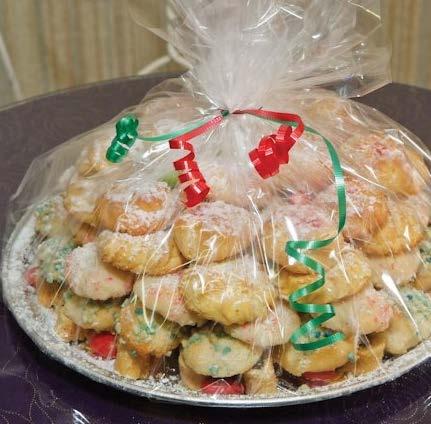
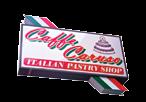











































































































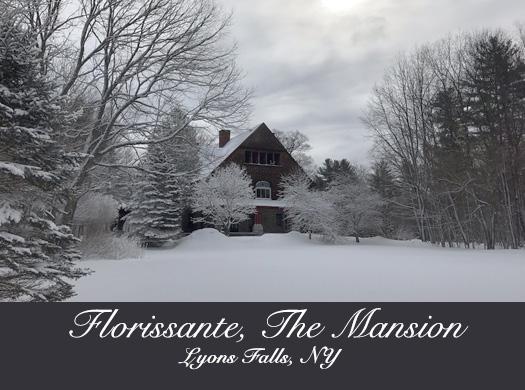

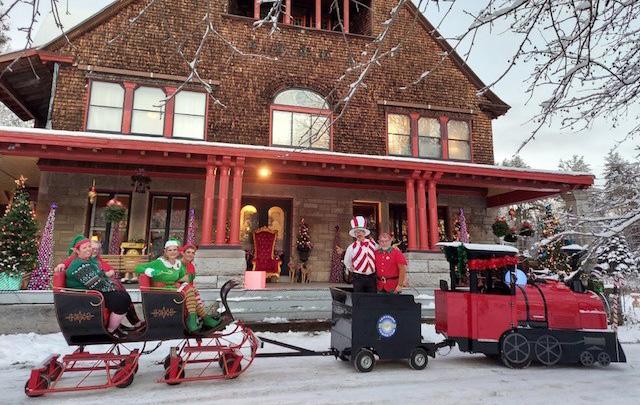


 by Suzie Jones
by Suzie Jones


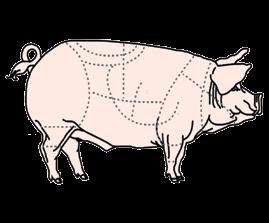

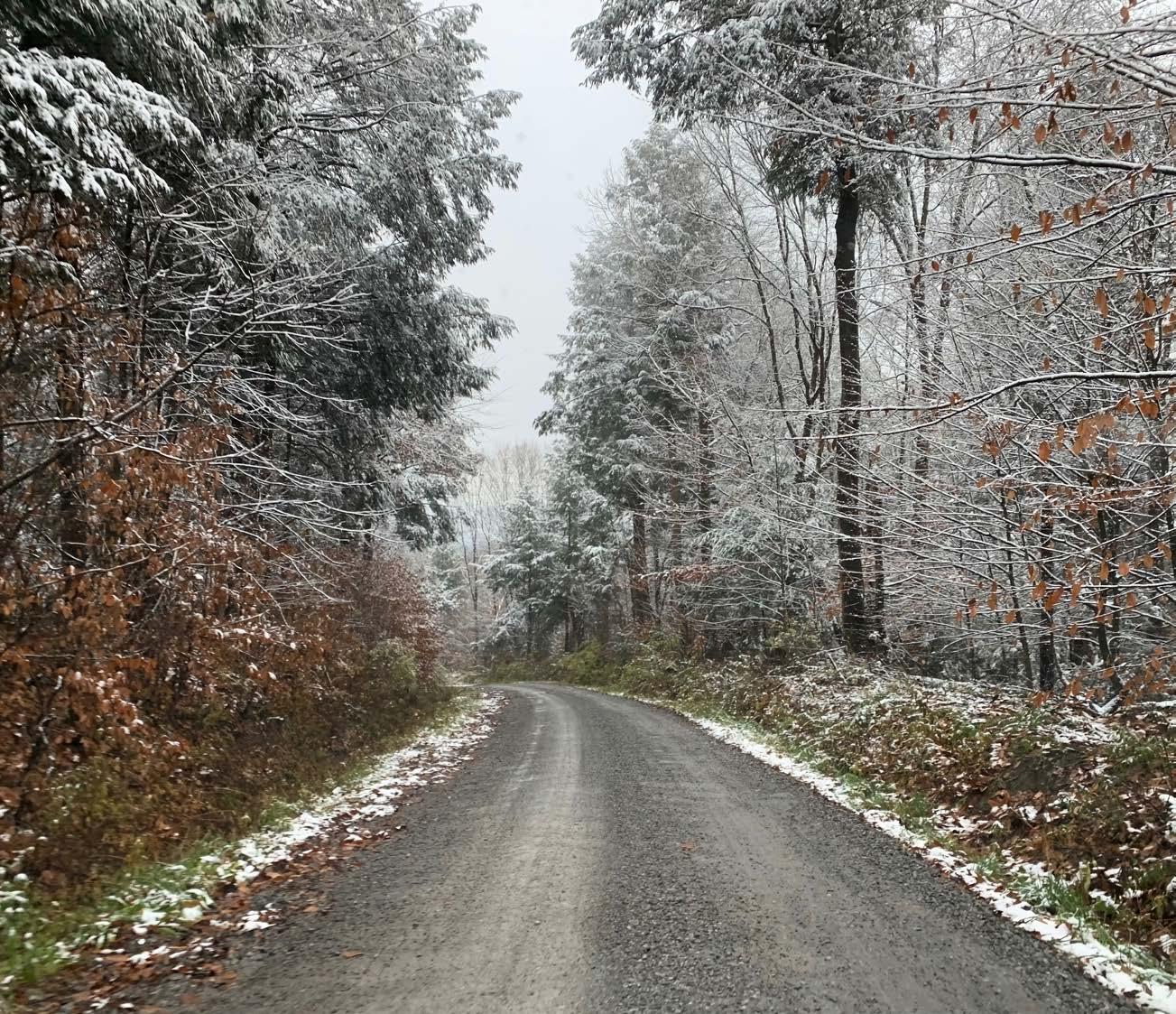


As I write, it is snowing on the farm. It is one of those qui et, nighttime snowfalls that seem to muffle all sound. There is no traffic on the slick roads, the goats and sheep are tucked away in their dry barn, and even the coyotes have taken a break from their nightly chatter. It is bliss.






Our farm is up in the hills above the West Canada Creek, high above the valley. Here, the weather can be startlingly different from whatever is going on in town.
On hot summer days, it can be a good 5-10 degrees cooler on the farm, with a lovely breeze to boot. In the winter, it means a light rain in town can turn into big, fluffy snowflakes halfway up the hill. By the time you crest the road to our farm, visitors will find a good 2-3 inches of snow and a virtual win

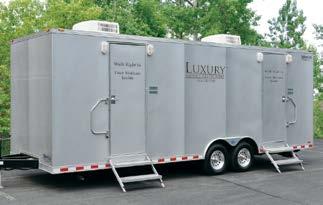

ter wonderland while the rest of the valley is still in mud sea son.
It is both a blessing and a curse.
The summer breezes mean we barely have any mosqui tos on our hill. The cooler temps and deep woods give us and our animals an escape from the worst August heat. You just can’t beat summer in the country!
But winter here is another story entirely. Our rural road is open only seasonally, meaning we live on a dead-end road for nearly 6 months of the year. Traffic to our farm store drops precipitously, as the less adventurous amongst our customers decide to wait until spring to visit. We can go days without seeing another soul, other than the plow driver, mail carrier, and the next-door neighbor.
This seasonal isolation was very difficult for me at first. But I have grown to appreciate it, perhaps even protective of it. And when I consider parts of the country that are even more isolated, and the people that choose that lifestyle, I un derstand its lure.
But we have holiday parties, school concerts, and family visits this December. REAL isolation begins in January! Why not make a special treat this holiday season with cheese from our farm? This no-bake “cheesecake in a cup” recipe is as versatile as it is simple:

Cheesecake
1 lb Jones Family Farm Kuyahoora Crème Cheese

1 can (14 oz) sweetened condensed milk
1 tsp vanilla extract
1 pack graham crackers, crushed
2 T butter, melted pinch salt
Blend first three in gredients until smooth. Mix last three ingredi ents until incorporated. Pour a heaping table spoon of the graham cracker mixture into the bottom of cup, top with crème cheese mixture. Top with an additional sprinkle of cracker mixture (op tional.) Chill for one hour and enjoy! (Makes 6-12 cups of cheesecake.)
Variations:


Try topping your cheesecake with blueberry pie filling or fresh lemon zest. Change it up entirely and crush Oreos for the cracker base and dust the top of the cheese cake with crushed peppermint candies OR substitute ginger snaps for the base and add ½ cup of pumpkin and pumpkin pie spice to the cheese mixture. The possibilities are endless! •
Suzie Jones and her husband, Peter, own Jones Family Farm in Herkimer. Together, with their children, they pro duce specialty goat cheeses and gelato. Find them at local farmers’ markets and online at www.anotherjonesfamilyfarm.com
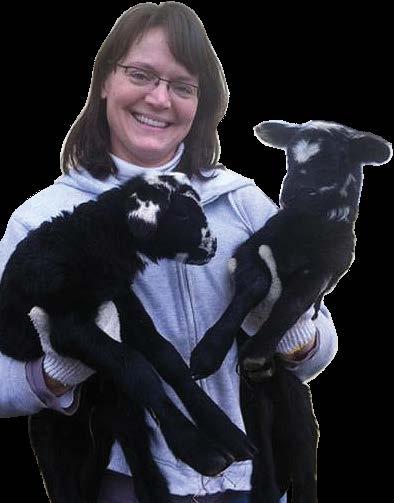
please support Our sponsors, they make this magazine possible
Paca Gardens . . . . . . . . . . . 5
Antiques & Art Westmoreland . . . . . . . . 16
Attic Addicts . . . . . . . . . . . . . . . . 16
Black Cat Antiques . . . . . . . . . . . . . . 17
Broad Street Flea Market . . . . . . . 17
The Bull Farm Antiques . . . . . . . . . . 17
Dawn Marie’s . . . . . . . . . . . . . 17
Little Falls Antique Center . . . . . . . 18
Madison Inn Antiques . . . . . . . . 18
Mohawk Antiques Mall . . . . . . . 2
Mohawk Valley Community Market . . . 18
The Potting Shed Antiques . . . . . . . 17
Showcase Antiques . . . . . . . . . 18
Victorian Rose . . . . . . . . . . . 18
Weeden’s Mini Mall . . . . . . . . . . 18
Whistle Post Antiques . . . . . . . . 17
Fusion Art Gallery . . . . . . . . . . . . 39
MWPAI Fountain Elms . . . . . . . . . . 3
View Arts . . . . . . . . . . . . . 22
Art and Custom Framing
Fusion Art Gallery . . . . . . . . . . . 39
Azure Arts Pottery . . . . . . . . . . . . 27
Steet-Ponte Auto Group . . . . . . . . . 47
Automotive Repair and Towing
Clinton Collision . . . . . . . . . . . . . 44
Bakeries
Caruso’s Pastry Shoppe . . . . . . . . 39
Karam’s Middle East Bakery . . . . . 13
Ramon’s Bakery . . . . . . . . . 14
Banks Bank of Utica . . . . . . . . . . . 8
Dick’s Wheel Shop . . . . . . . . . . 24
Berry Hill Book Shop. . . . . . . . . 32
Keaton & Lloyd Bookshop . . . . . . . . 24
Treehouse Reading Room . . . . . . . . 33
Cabinets and Kitchens
Custom Woodcraft . . . . . . . . . 10
Knotty By Nature . . . . . . . . . 36
Candy
So Sweet Candy Shoppe, Utica . . . . . . . 26
Catering
B Blossom Catering . . . . . . . . . . 10
RoSo’s Cafe & Catering . . . . . . . . . . . 14
Willie’s The Original Bagel Cafe . . . . . . 15
CBD Products
Utica Hemp, New Hartford . . . . . . . . 33
Cheese (See Produce, Local)
Christmas Trees
Naturewood Knoll . . . . . . . . . . . . 21
Massoud’s Tree Farm . . . . . . . . . . . . 32
Clothing Consignment
The Queen’s Closet . . . . . . . . . . . . 16
Contractors
Ed Smith Contractor and Handyman . . . 31
Deansboro Superette . . . . . . . . . . . 23
Meelan’s Meat Market . . . . . . . . . . . . . 31
Charlie’s Place . . . . . . . . . . . . . . 13
Riverside Diner . . . . . . . . . . . . 14
Sheri’s Eastside Diner . . . . . . . . . . . . . . 14
Wendy’s Diner . . . . . . . . . . . . . . 15
Barney’s Angels . . . . . . . . . . . . . 33
Doors, Residential & Commercial
JM Door Co. . . . . . . . . . . . . . 41
Attic Addicts . . . . . . . . . . . . . . . 16
The Potting Shed Antiques . . . . . . . . . . 17
Events, Entertainment, and Activities
Florissante Mansion Tours . . . . . . . . 39
Goodsell Museum . . . . . . . . . . . . 38
Hamilton College Performing Arts . . . . . 12 Richfield Springs Scenic Railway . . . . . . . 21
Clinton Tractor . . . . . . . . . . . . . 42
Hobby Hill Farm Sales . . . . . . . . . . 43 White’s Farm Supply . . . . . . . . . . . . 48
Farm Markets
Horn’s Family Farm . . . . . . . . . . . 28 North Star Orchards . . . . . . . . . . . 30
Financial Services
Van Meter & Van Meter . . . . . . . . . . 20
Enjem’s Flooring America . . . . . . . . . . 7 Mike’s Floor Store . . . . . . . . . . . . 34
Florists
LaBella’s Flowers . . . . . . . . . . . . 19
Food Scraps Collection Service
CNY Green Bucket Project . . . . . 32 & 46
Funeral Services
Prince-Boyd & Hyatt . . . . . . . . . . . 41
Ironwood Furniture . . . . . . . . . . . . 38 Jeff’s Amish Furniture . . . . . . . . . . 23 John Froass & Son . . . . . . . . . . 9 Shoppes at the Finish Line . . . . . . . . 32
Furniture Makers
Custom Woodcraft . . . . . . . . . . . 10
Garden Centers and Greenhouses
Casler Flower Farm . . . . . . . . . 21
Green Lakes Home & Garden . . . . . . . 22
North Star Orchards . . . . . . . . . . . 30
Twin Orchards . . . . . . . . . . . . 22
Ed Smith Contractor and Handyman . . . 31
Bonnie’s Country Store . . . . . . . . . . 36 Deansboro Superette . . . . . . . . . . . . 23
The Artisans’ Corner . . . . . . . . . . . 37
Between Us Sisters . . . . . . . . . . . 10
Fair Trade Shoppe . . . . . . . . . . 25
Fusion Art Gallery . . . . . . . . . . . 39
Krizia Martin . . . . . . . . . . . . . . 26
Shoppes at Johnny Appleseed . . . . . . . 12 Shoppes at the Finish Line . . . . . . . . 32
Speedy Awards & Engraving . . . . . . 26
The Tepee . . . . . . . . . . . . . 34
Whistle Post Creations . . . . . . . . 17
Bosonne’s Sausage . . . . . . . . . . . . . 41
Deansboro Superette . . . . . . . . . . . . 23
Little Italy Imports . . . . . . . . . . . . 33
Olde Kountry Market . . . . . . . . . . . 22
Pulaski Meat Market . . . . . . . . . . . . 11
Lincoln Davies . . . . . . . . . . . . . . . 9
Morgan’s Hardware . . . . . . . . . . . . . 44
Turner Lumber . . . . . . . . . . . . . . 36
Wightman Specialty Woods . . . . . . . . . 21
Vitality Fitness and Wellness . . . . . . . . . 34
Insurance
HBE Group, Inc. . . . . . . . . . . . . . . . 35
Turnbull Insurance . . . . . . . . . . . . . . 36
The Added Touch Drapery . . . . . . . . 24
Ironwork
Raulli’s Iron Works . . . . . . . . . . . . 34
Jewelry
Alison’s Jewelry & Repair . . . . . . . . 25
Fall Hill Bead & Gem . . . . . . . . . . 27
Goldmine Jewelers . . . . . . . . . . . . 31
Lighting Mills Electrical Supply . . . . . . . . . . . 40
Liquor Stores and Wine
Ilion Wine & Spirits . . . . . . . . . . . 19
Prospect Falls Winery . . . . . . . . . . 23
Trenton Station Liquor & Wine . . . . . . . 34
Maple Syrup (See Produce)
Local Meats
Sunnybrook Farm . . . . . . . . . . . . 40
Media
Weekly Adirondack . . . . . . . . . . . . 34
Monuments & Memorials
Yorkville Memorials . . . . . . . . . . . . . 28
Natural Food
Cooperstown Naturals . . . . . . . . . . . 44 Peter’s Cornucopia . . . . . . . . . . . 6
Optometrists Towpath
. . . . . . . . . . . . 20
All Seasons Outfitters . . . . . . . . . . . . 29
Paint
Urbanik’s Paint & Wallpaper Co. . . . . . . 29
Physical Therapy
Inertia PT . . . . . . . . . . . . . . . . . 40
Pizzerias
DiCastro’s Brick Oven . . . . . . . . . . 13
Primo Pizzeria . . . . . . . . . . . . . 14
Tony’s Pizza . . . . . . . . . . . . . . . . 15
Mohawk Ltd. . . . . . . . . . . . . . 43
Primitives
Between Us Sisters . . . . . . . . . . . 10
Butternut Barn . . . . . . . . . . . . 17
Produce, Local

Ben & Judy’s Sugarhouse . . . . . . . 10
Horn’s Family Farm . . . . . . . . . . 28
Jewett’s Cheese . . . . . . . . . . . . . 33
Shaw’s Maple Products . . . . . . . . . . 36
Stoltzfus Family Dairy . . . . . . . . . . 7
Tibbits Maple . . . . . . . . . . . . . . 24
Quilt and Yarn Shops/Services
Tiger Lily Quilt Co. . . . . . . . . . . . . . 11
Restaurants and Cafés (See also Diners)
Ann St. Deli . . . . . . . . . . . . . . 13
Black Stallion Restaurant . . . . . . . . . . . 13
DiCastro’s Brick Oven . . . . . . . . . . . 13
Karam’s Middle East Bakery . . . . . . . 13 Killabrew . . . . . . . . . . . . . 13
Ohio Tavern . . . . . . . . . . . . . . 13
Phoenician Restaurant . . . . . . . . . . 14
RoSo’s Cafe & Catering . . . . . . . . . . 14
Route 69 Steakhouse . . . . . . . . . 14
Sammy and Annie Foods . . . . . . . . 14 Tailor and the Cook . . . . . . . . . . . 15
Willie’s The Original Bagel Cafe . . . . . . 15 The Willows . . . . . . . . . . . . . . 15
UTICA—Munson-Williams-Proctor Arts Institute announces the appointment of Stephen Harrison as Director of the Museum of Art and Chief Curator. Harrison came to Munson-Williams in November 2020 as the Deputy Director of the Museum.

As Director of the Museum, he will plan future exhibitions, en hance collection and interpretation initiatives, and develop stron ger community relationships and collaborations. He will continue to lead the education, curatorial, and registrar departments and support Munson-Williams President and CEO Anna D’Ambro sio with major initiatives, such as an institute-wide master plan, rebranding and Munson-Williams’ strategic five-year plan.
During his tenure at Munson-Williams, Harrison has spear headed major acquisition and deaccession efforts and established a new acquisition fund honoring the memory of Helen Munson Williams. He curated the 2022 Norman Rockwell exhibition, the most-attended summer exhibition in Munson-Williams’ history.
“I’m honored to be taking on this new role with such talented people at the Museum of Art when Munson-Williams is brim ming with so much promise and potential,” Harrison said. “I’ve received such a warm welcome in Utica, and I’m proud to be shar ing one of the best collections of American art in the world with our community and beyond.”
Harrison came to Munson-Williams with more than 25 years of experience, including as the Curator of Decorative Art and De sign at the Cleveland Museum of Art, where he oversaw a premier collection of American and European design. He has also held curatorial positions at the High Museum of Art in Atlanta, the Dallas Museum of Art, and the Louisiana State Museum in New Orleans. •
Roofing Contractors
Swarey Brothers Roofing . . . . . . . . . . . . 40
Shoes Karaz Shoes . . . . . . . . . . . . . 20
Signs Whistle Post Creations . . . . . . . . . . . . 17
Storage Sheds & Garages
Pleasant View Structures . . . . . . . . . 6
Tree Services and Tree Farms Rick Turk Tree Service . . . . . . . . . 31
Yogurt Stoltzfus Family Dairy . . . . . . . . . . . 7
Last Month’s Riggie’s Clinton Shopping Spree contest winner: Sally Destefanis of Barneveld
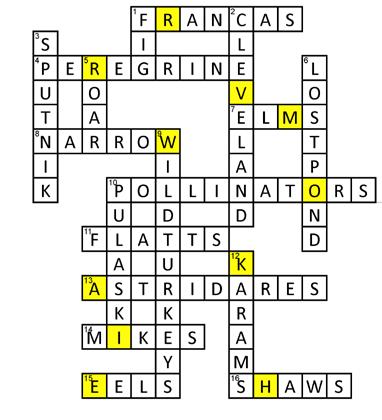
Our winner is Ron and Fran Pytko











KubotaUSA.com *Award based on 2021 Progressive Farmer Reader Insights Tractor Study. © Kubota Tractor Corporation, 2022. $0 Down, 0% A.P.R. financing for up to 60 months on purchases of new Kubota BX series equipment from participating dealers’ in-stock inventory is available to qualified purchasers through Kubota Credit Corporation, U.S.A.; subject to credit approval. Example: 60 monthly payments of $16.67 per $1,000 financed. Customer instant rebates of $300 are available on qualifying finance or $600 on cash purchases of BX2680 equipment. Additional instant rebates include $200 with purchase of the first new qualifying implement and $200 for the second new qualifying implement. Some exceptions apply. Offers expire 12/31/22. Terms subject to change. This material is for descriptive purposes only. Kubota disclaims
